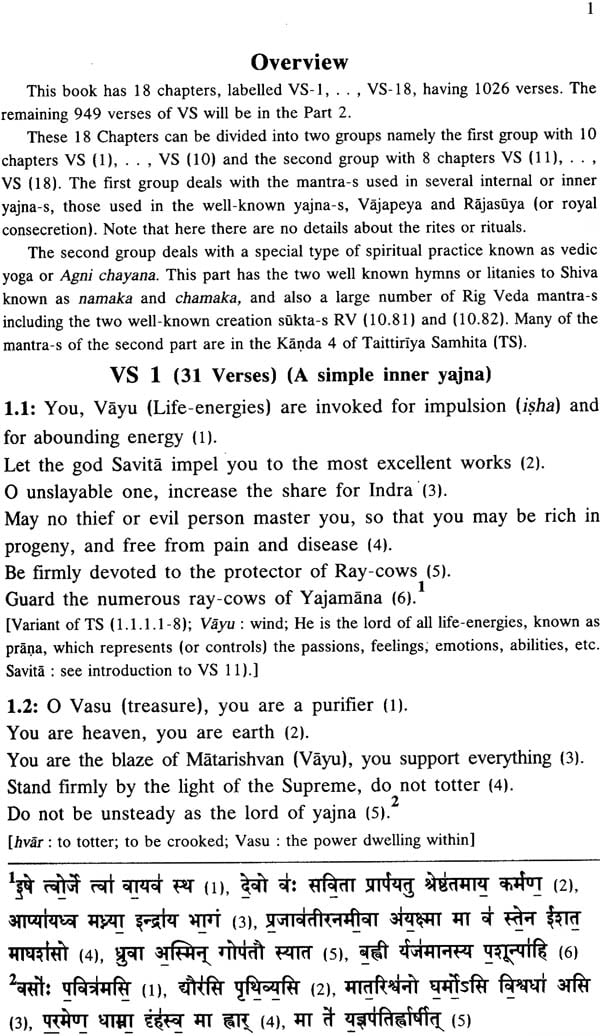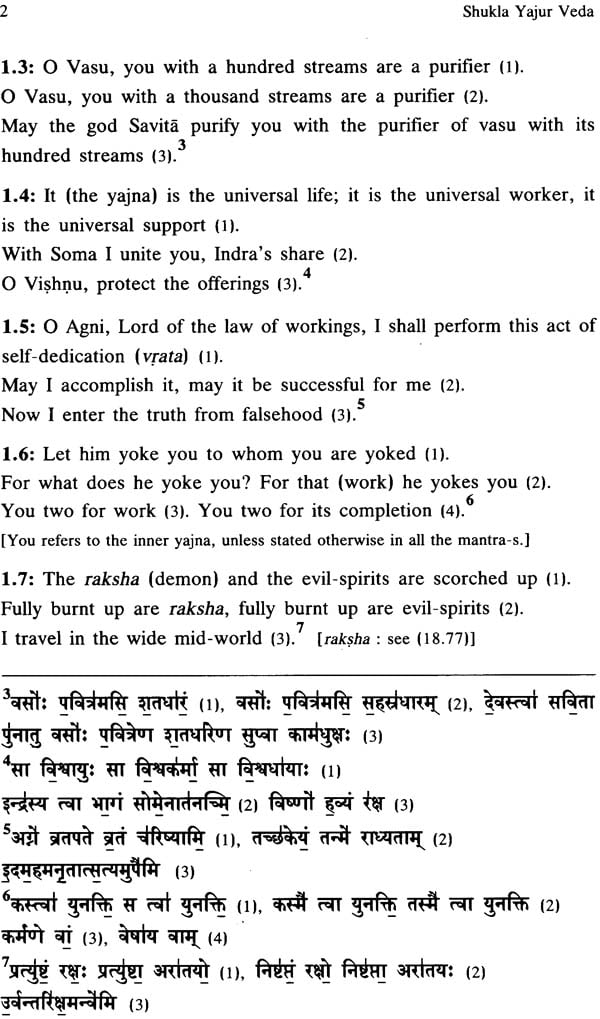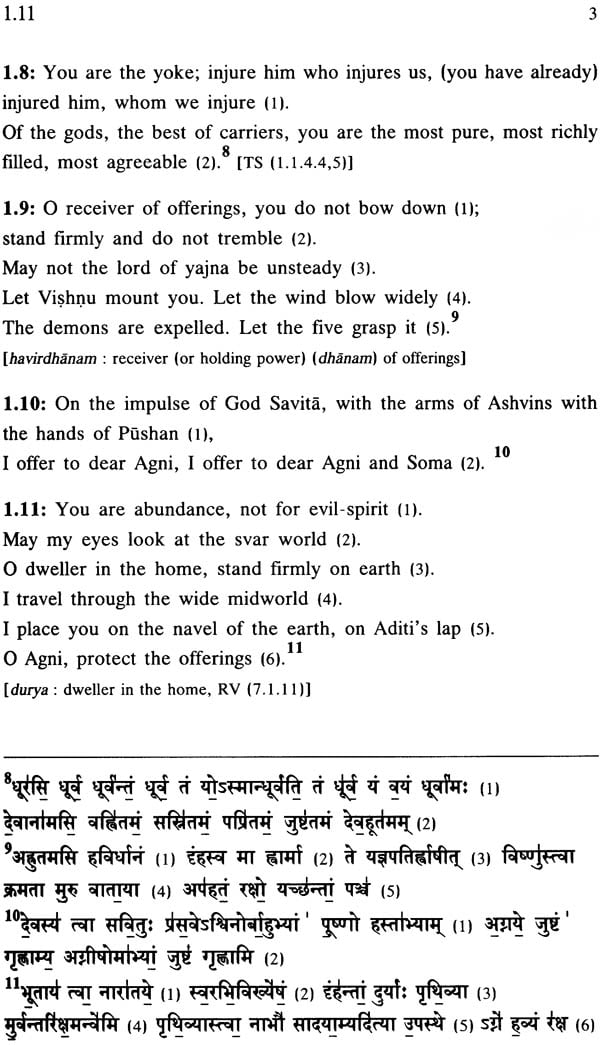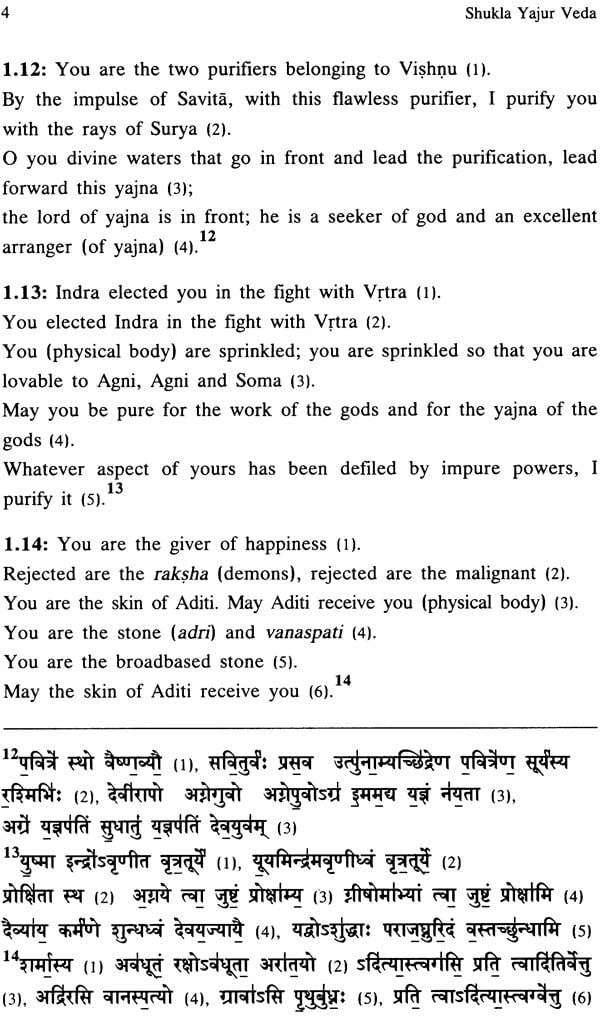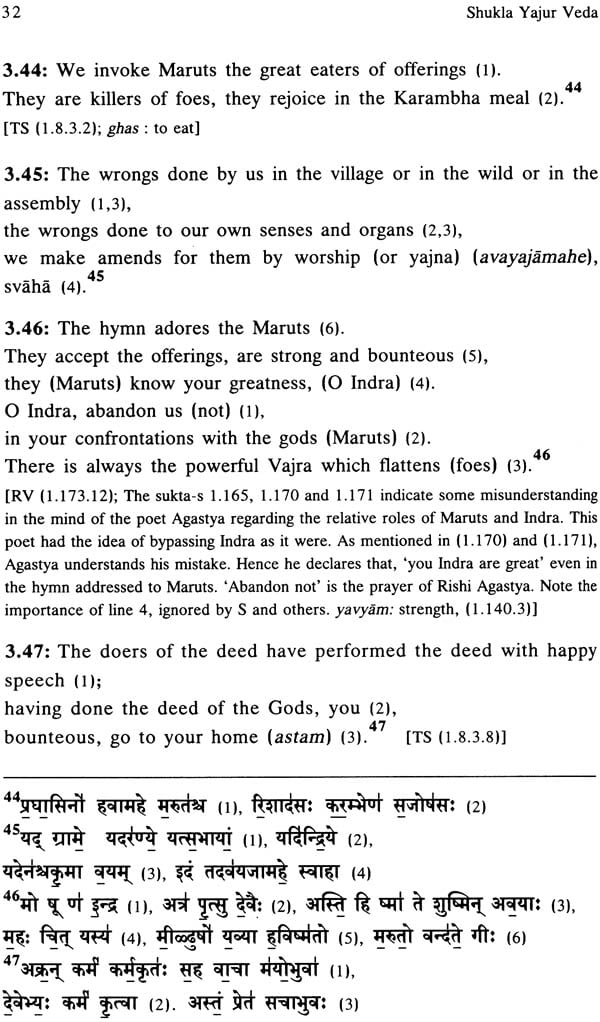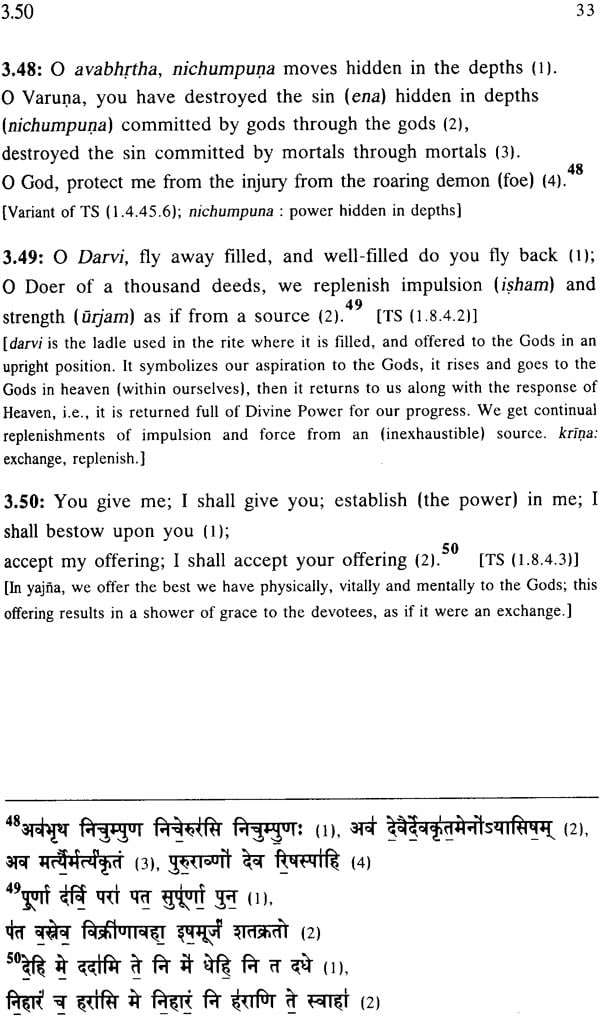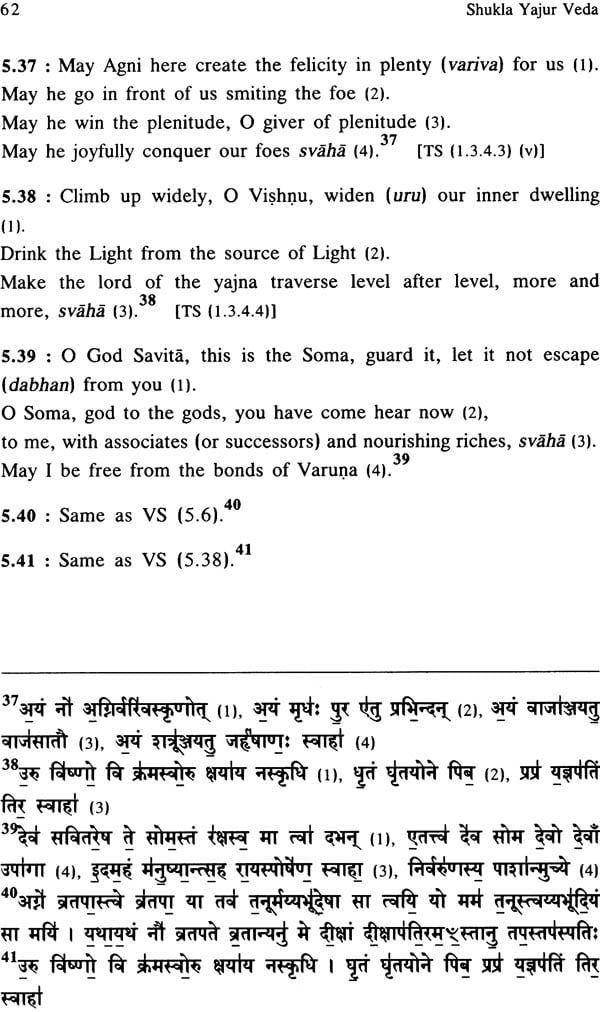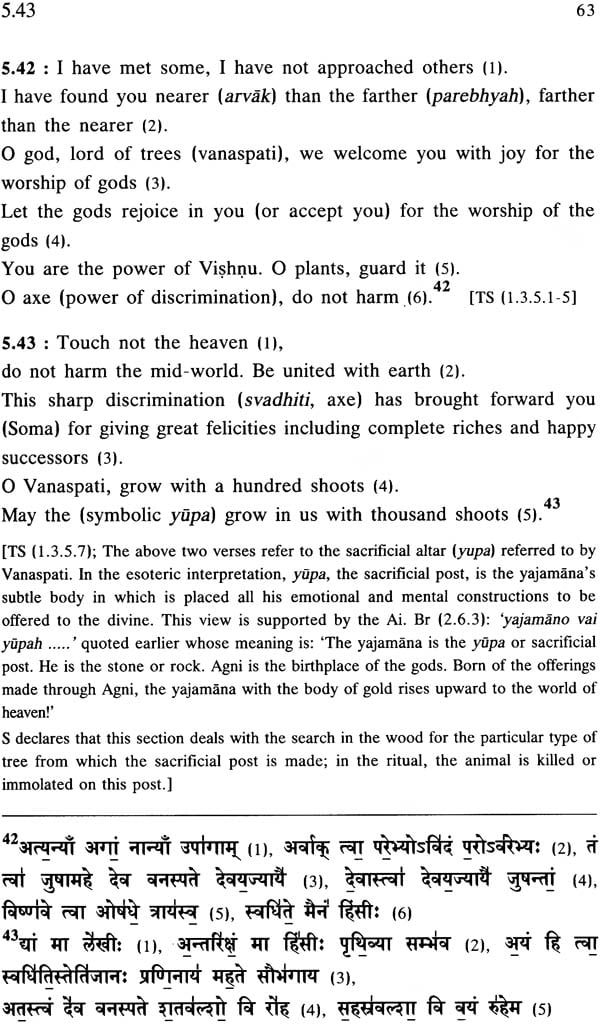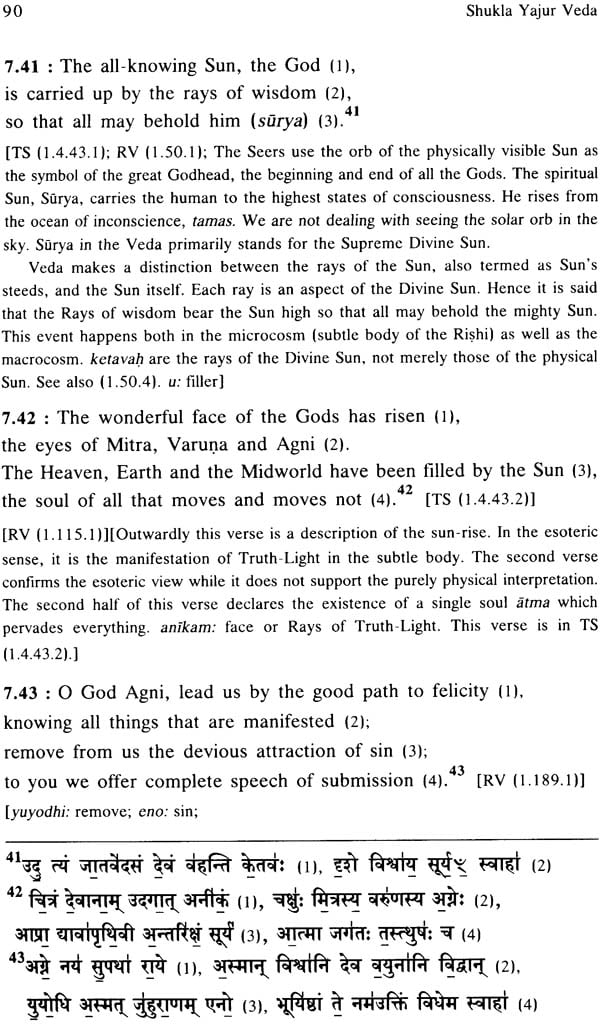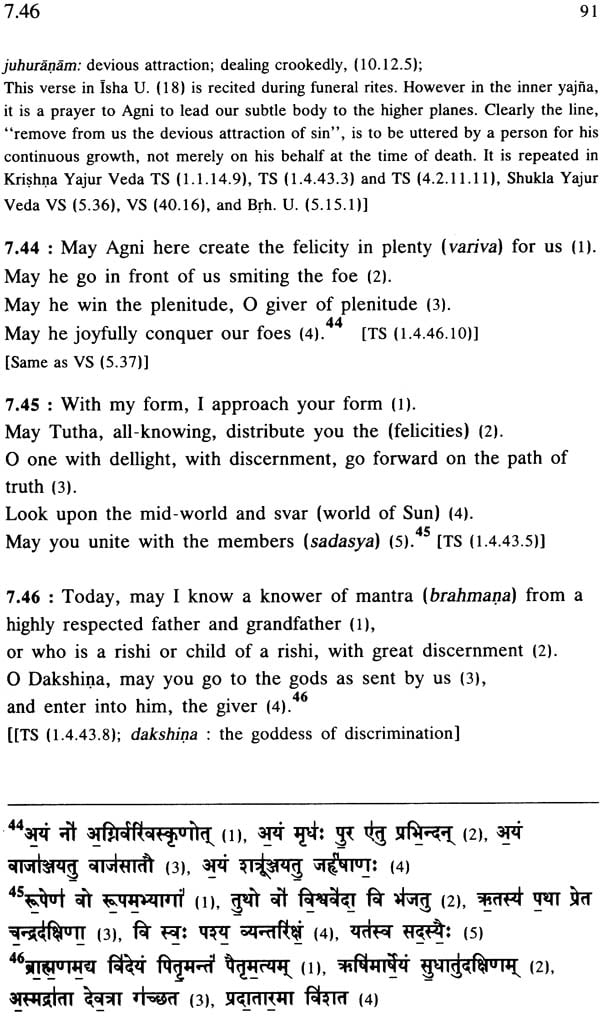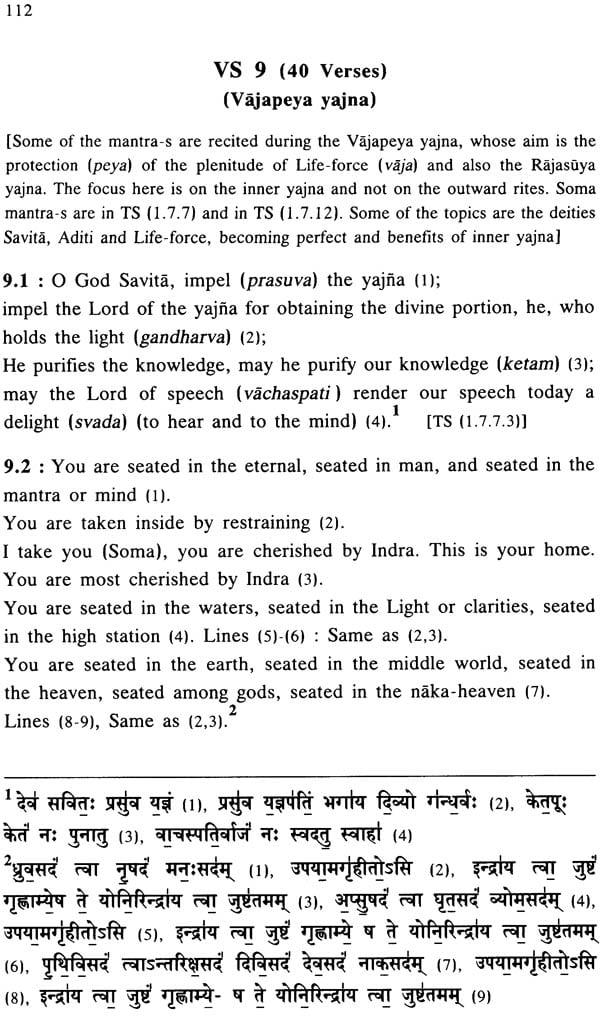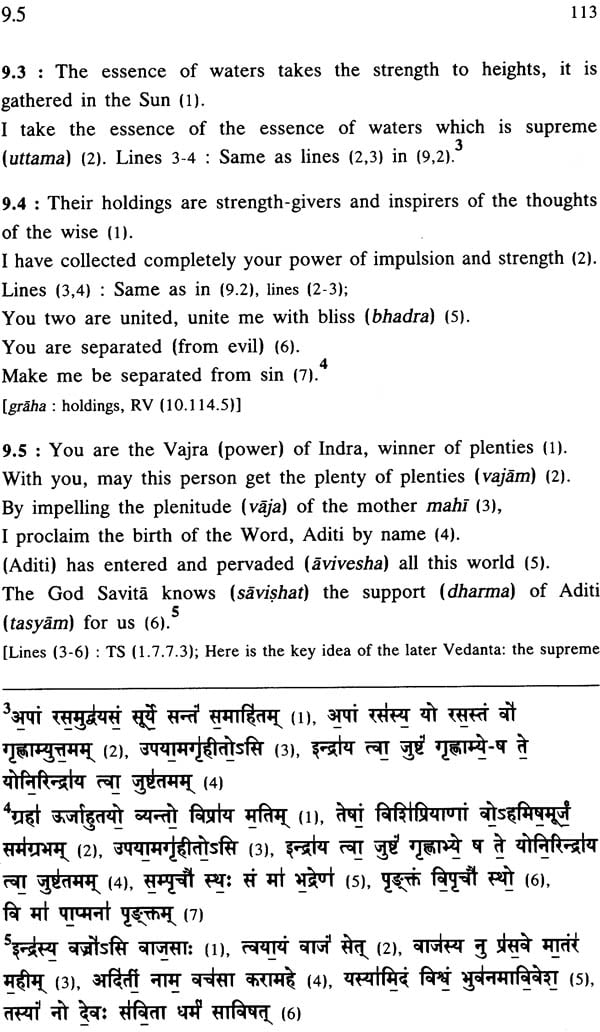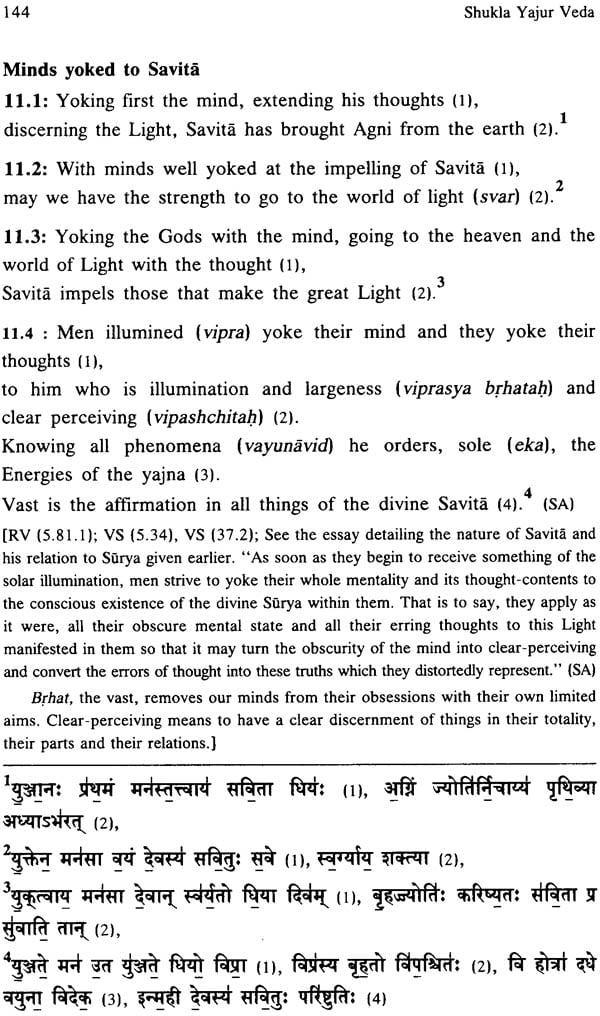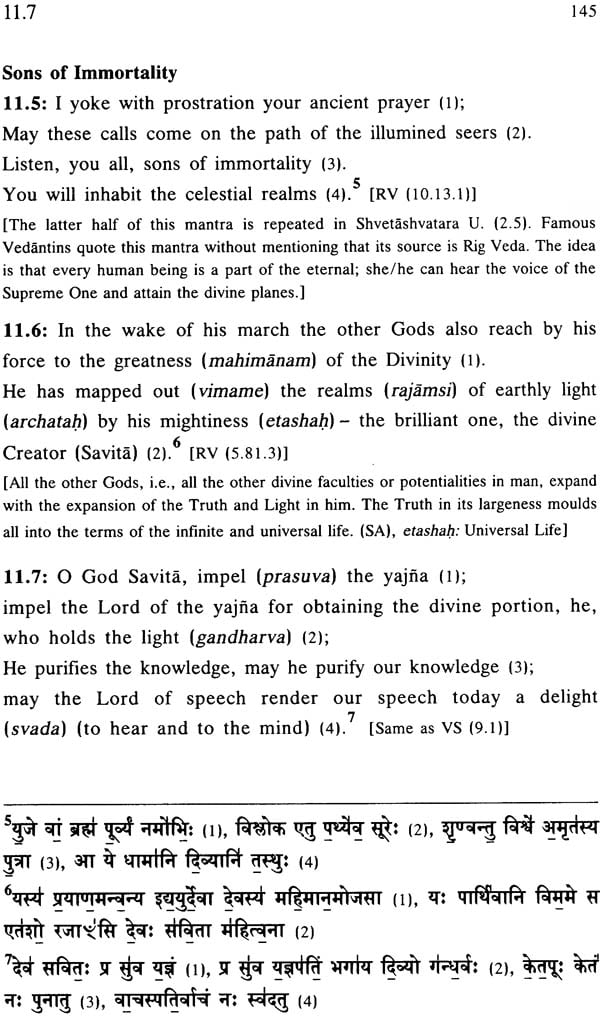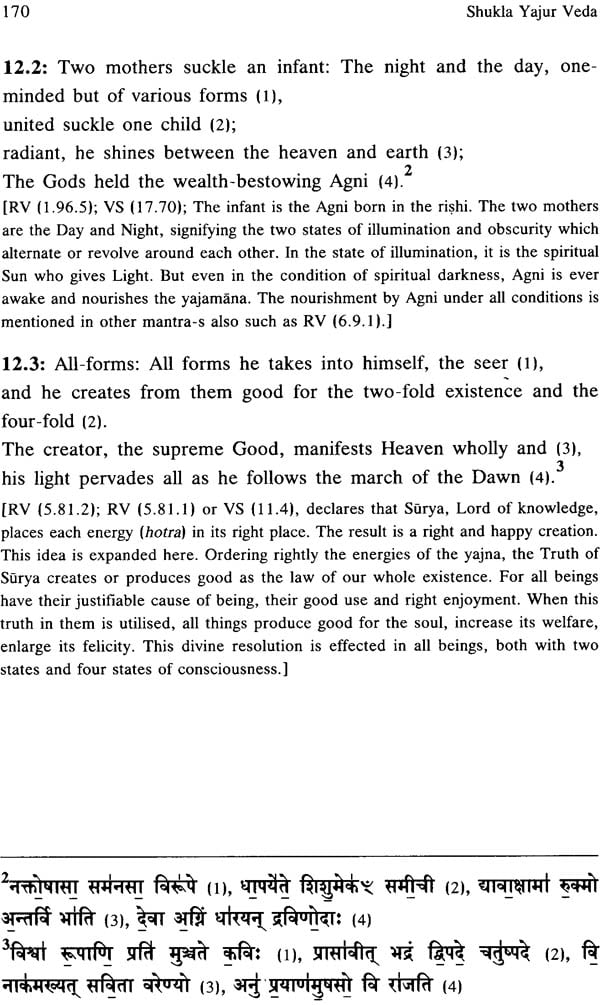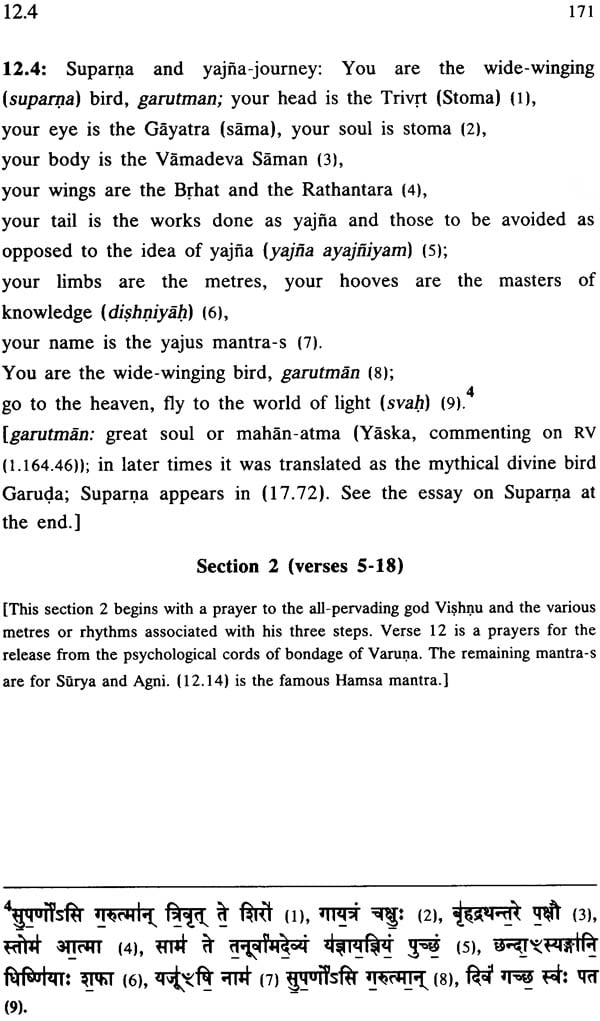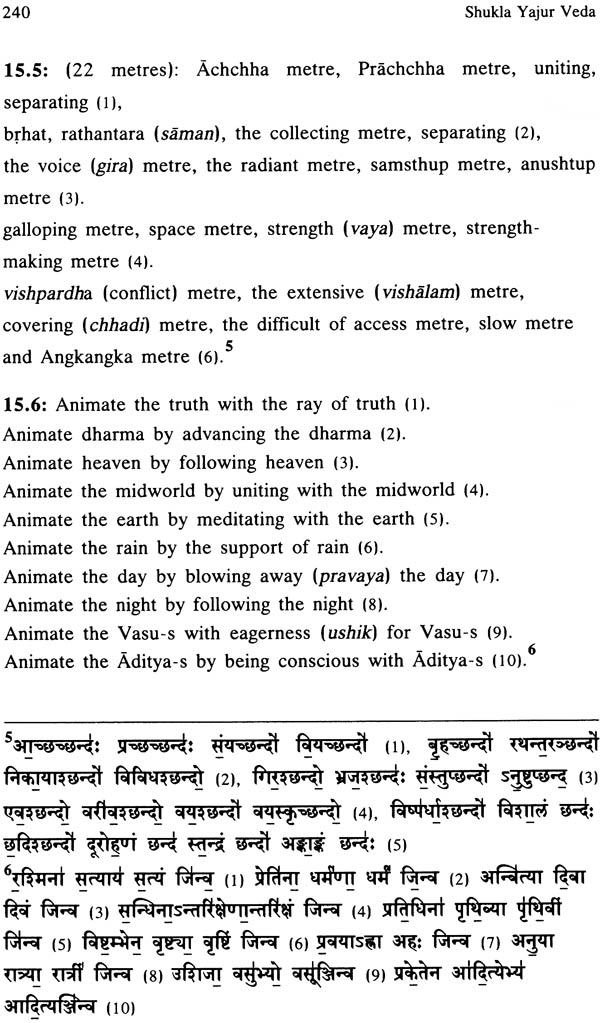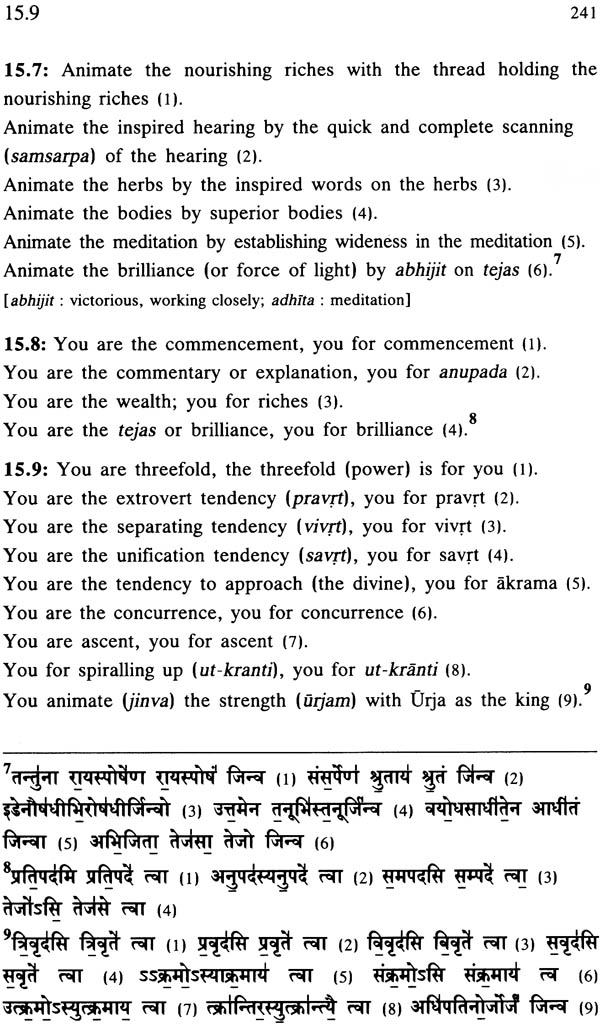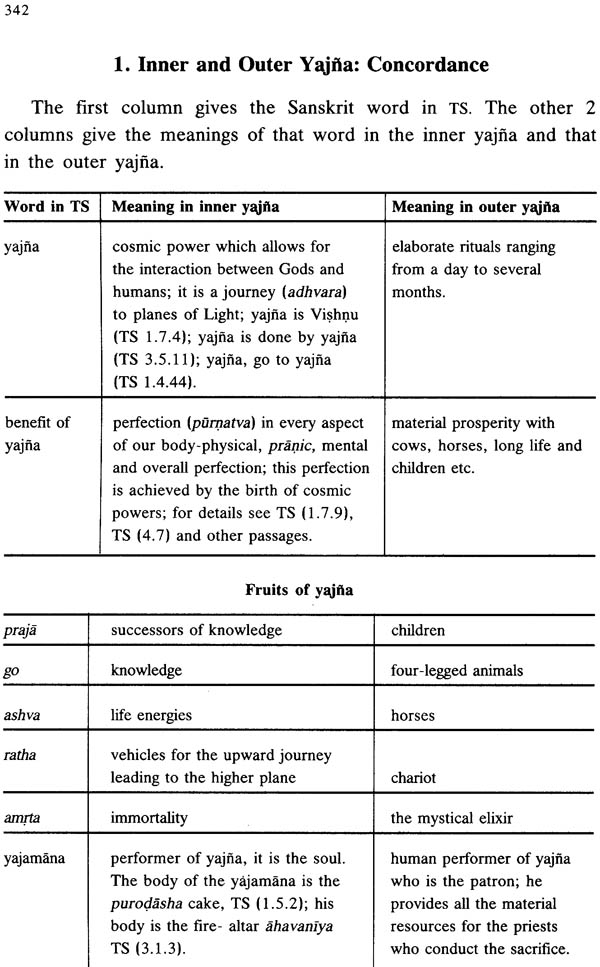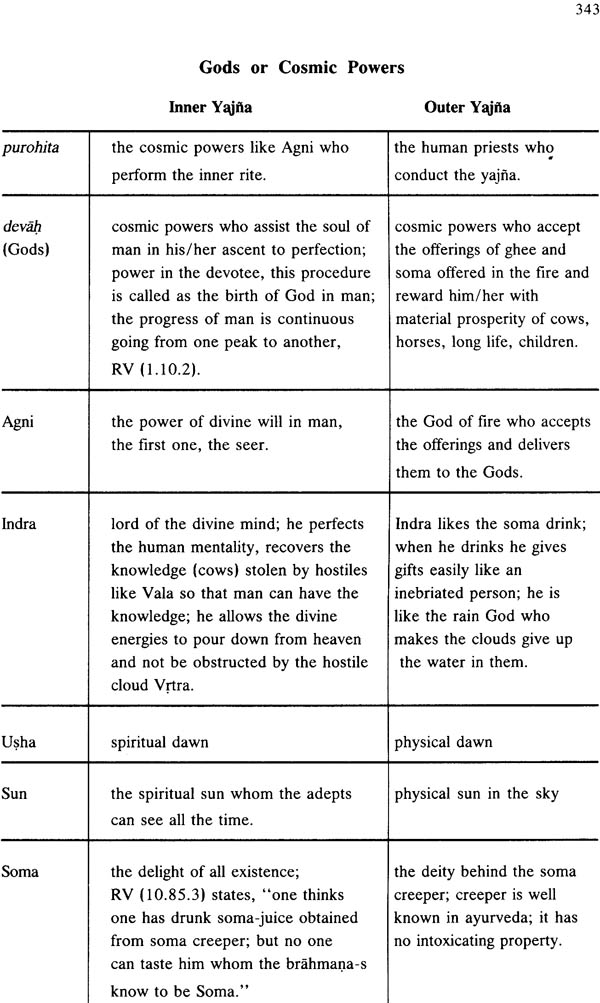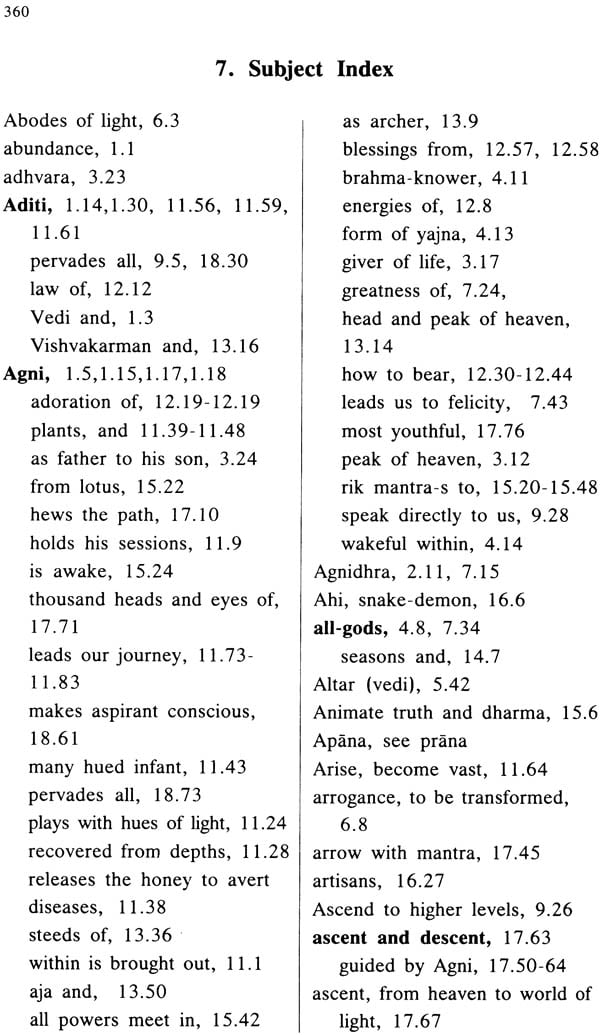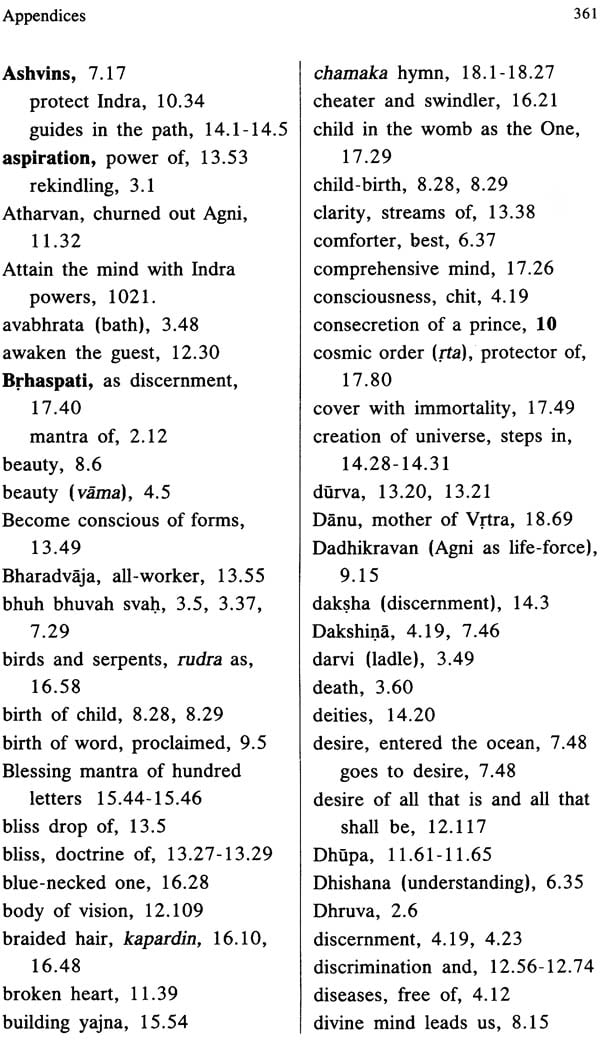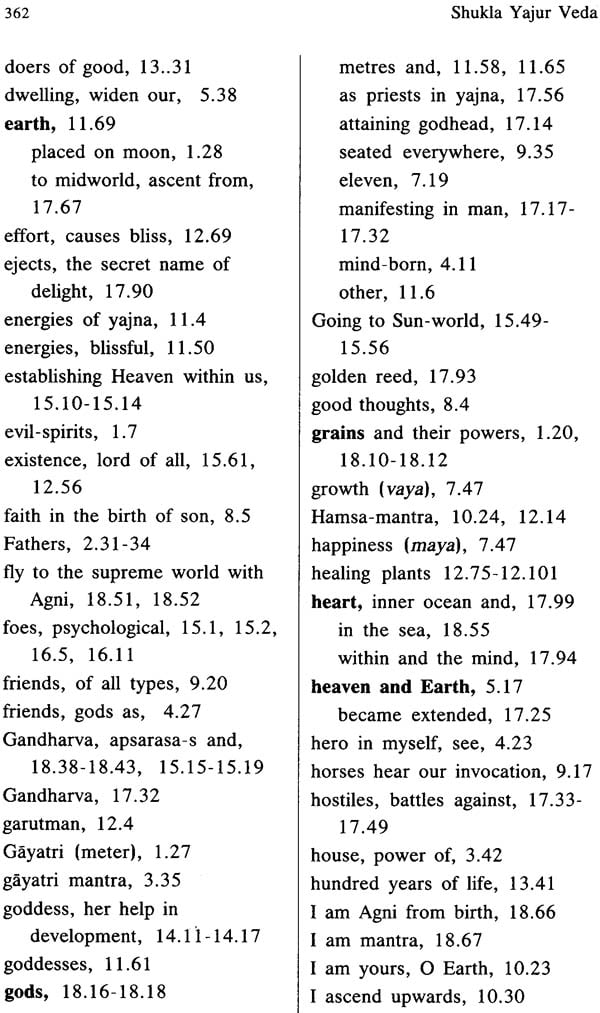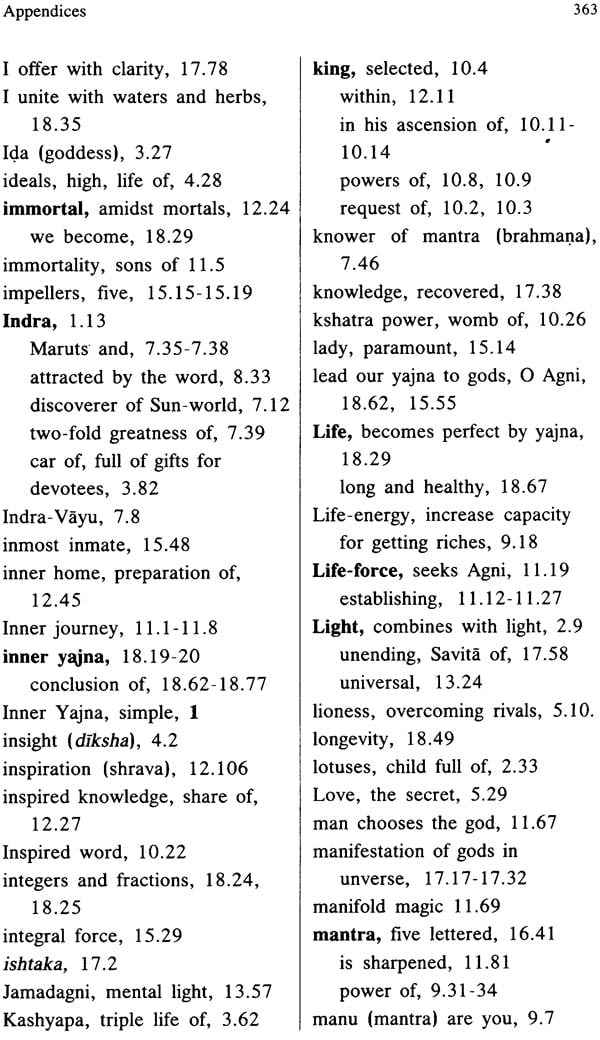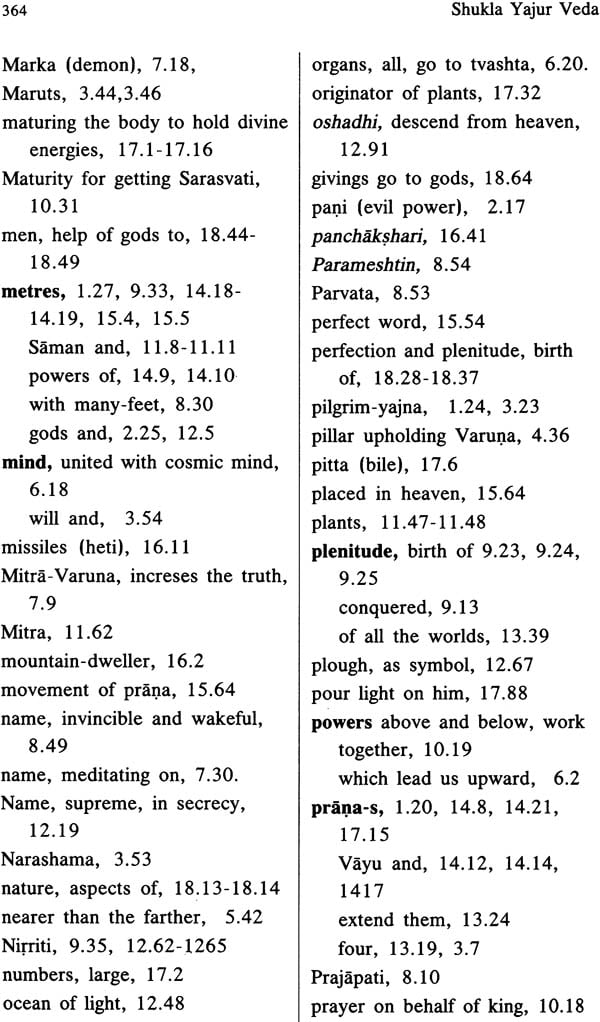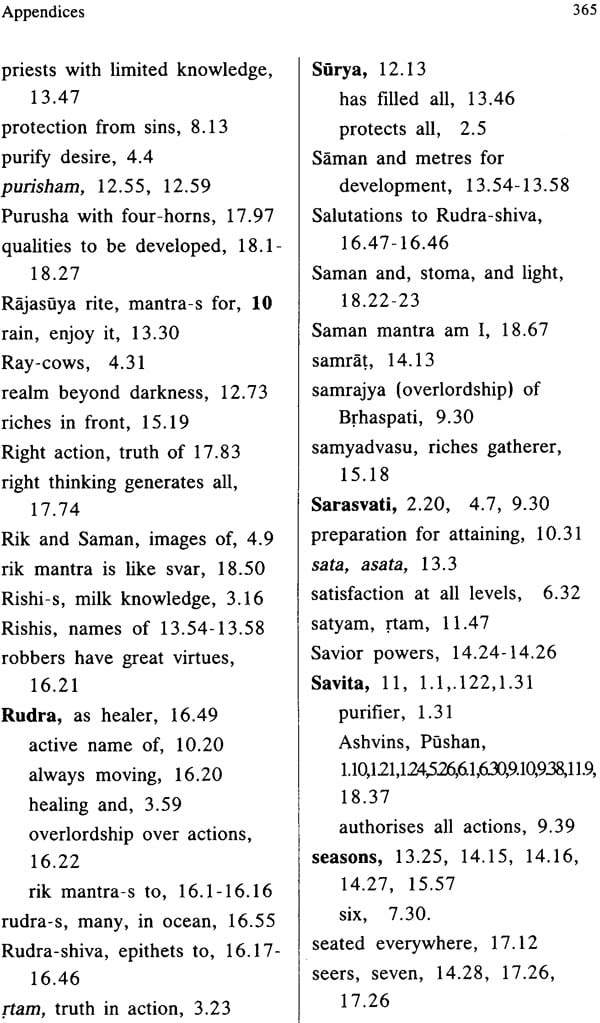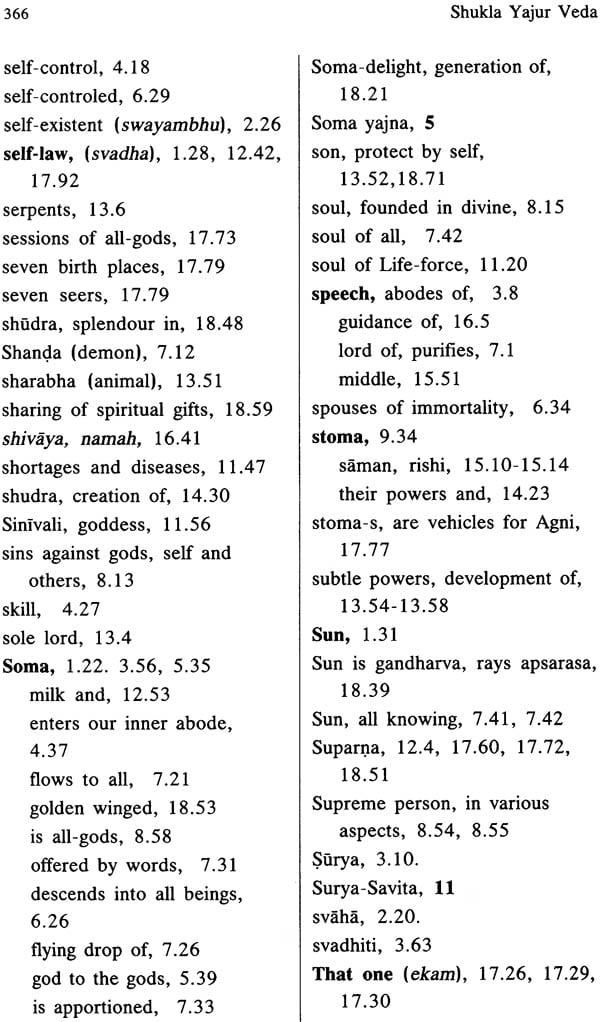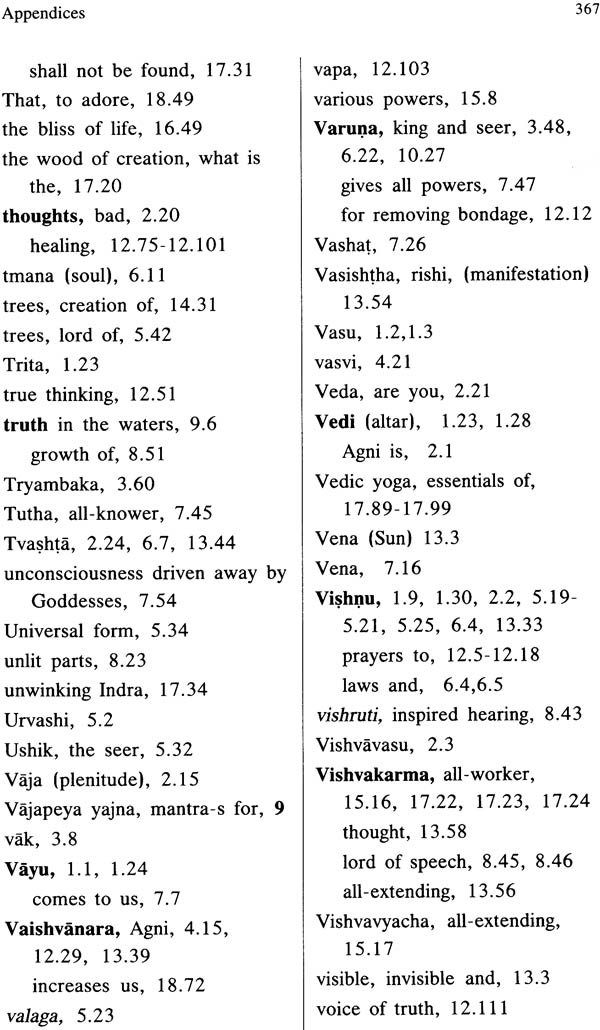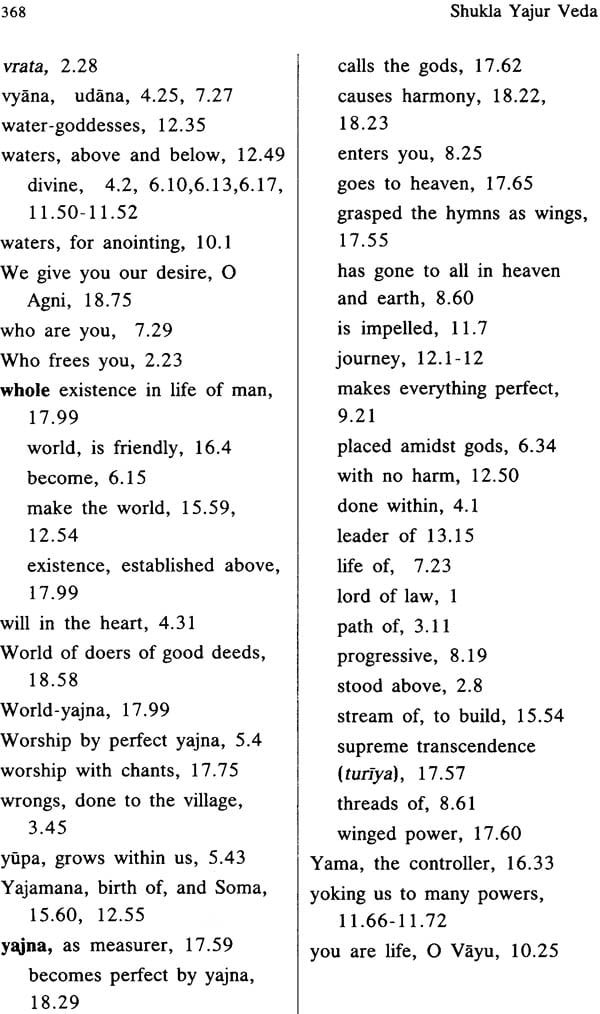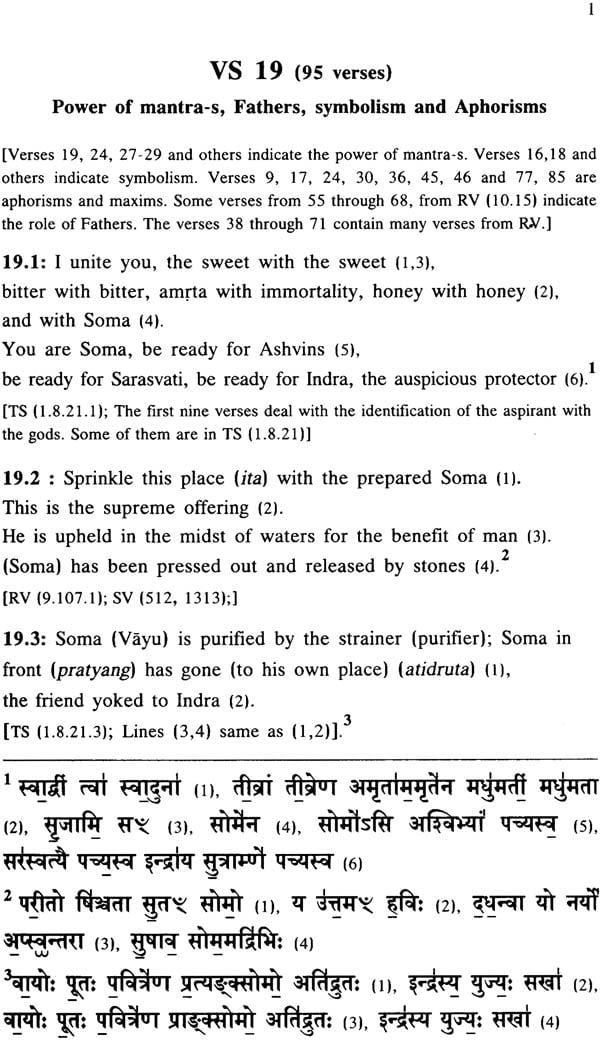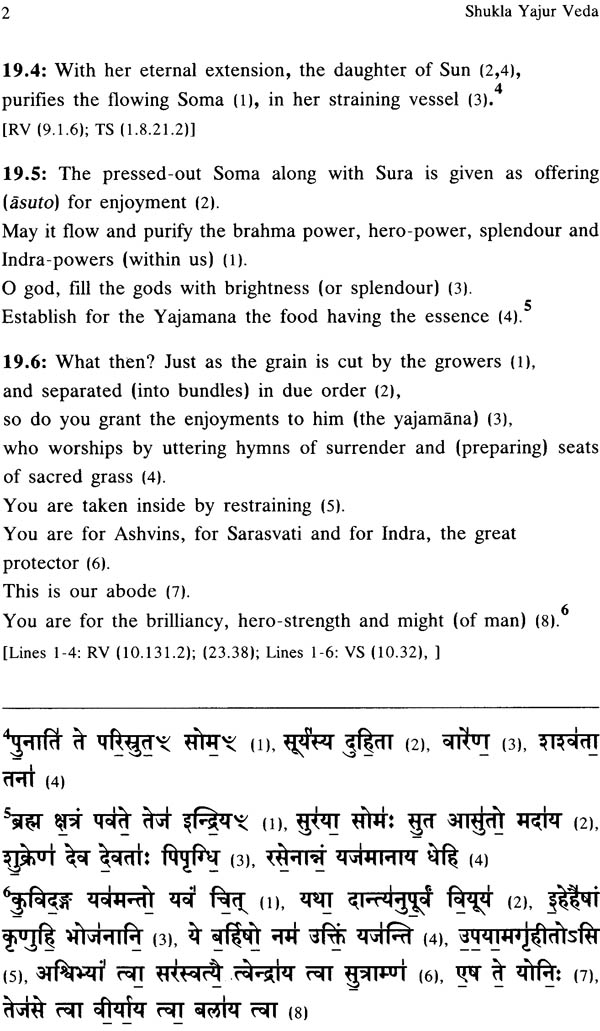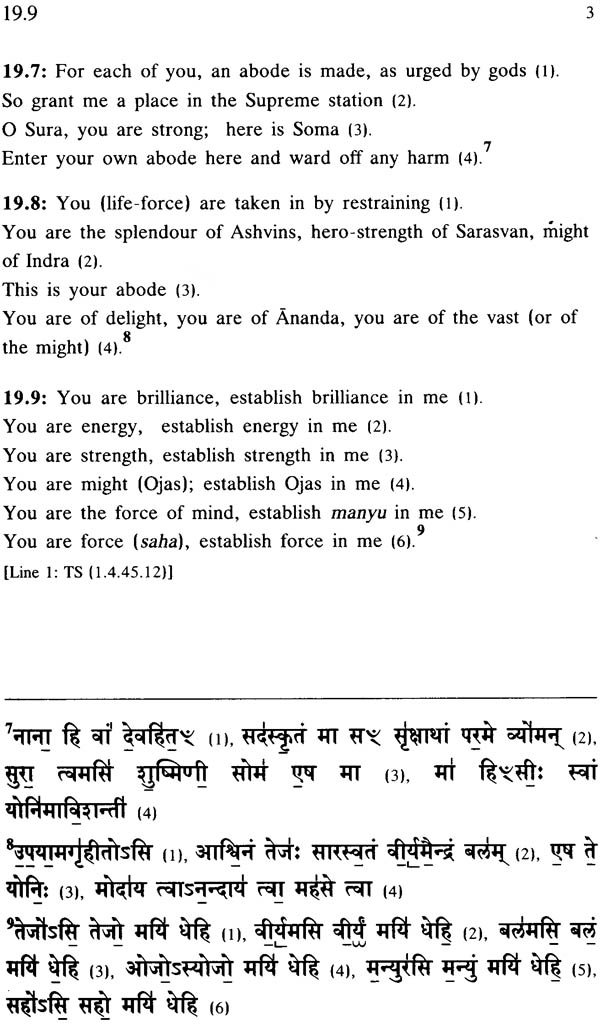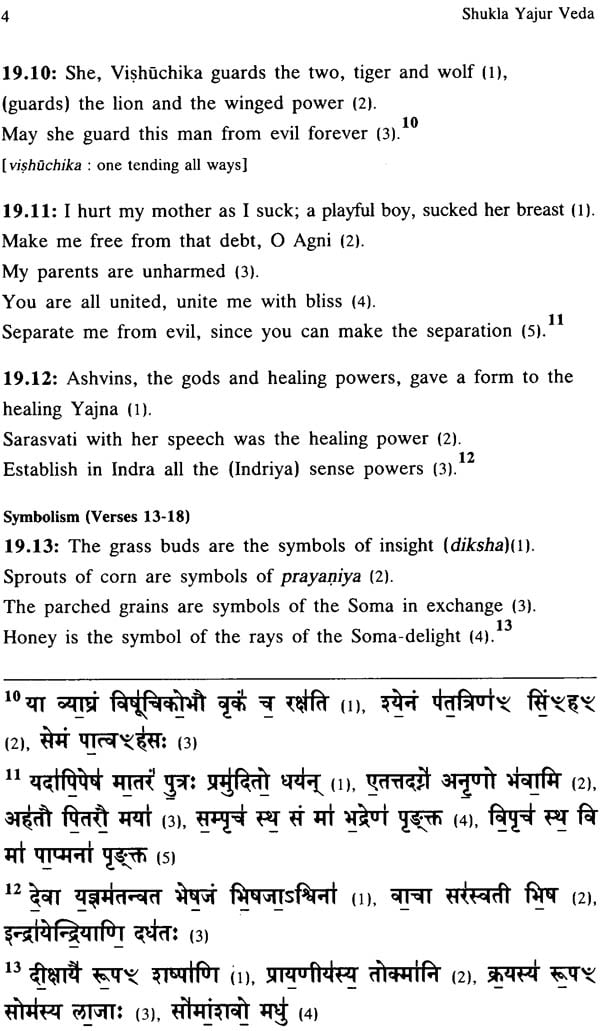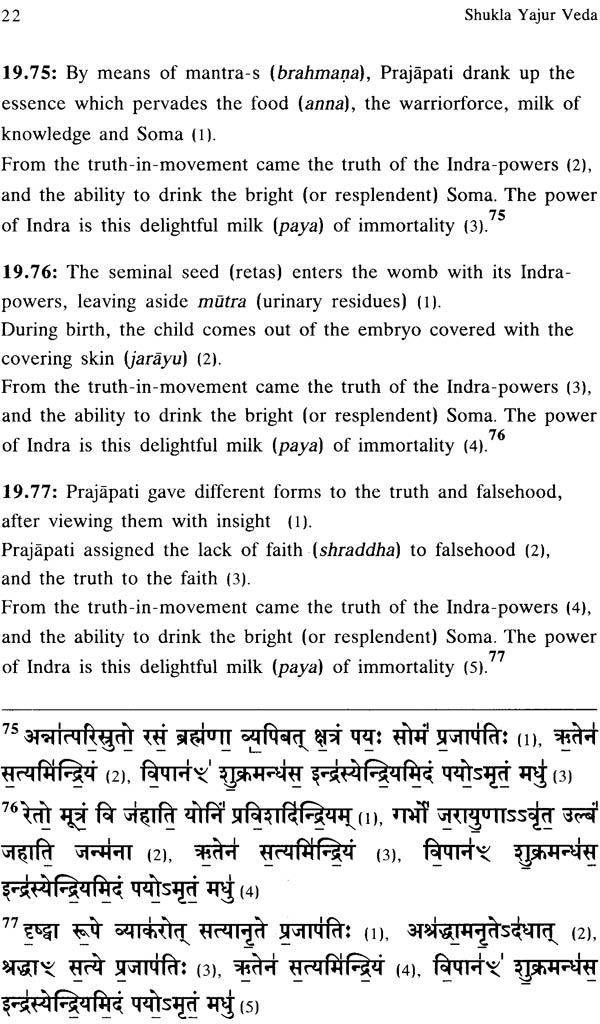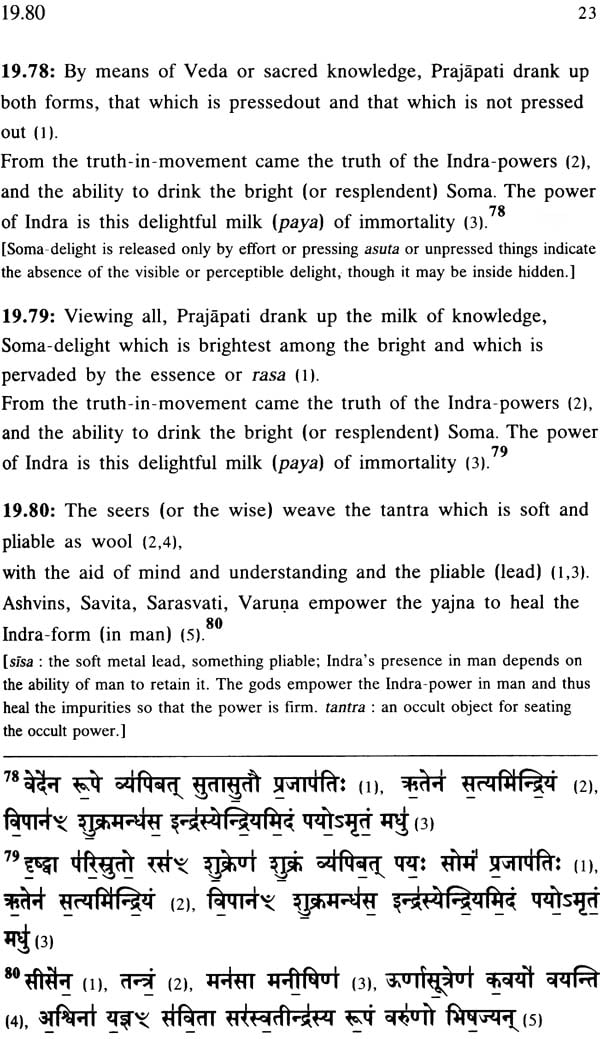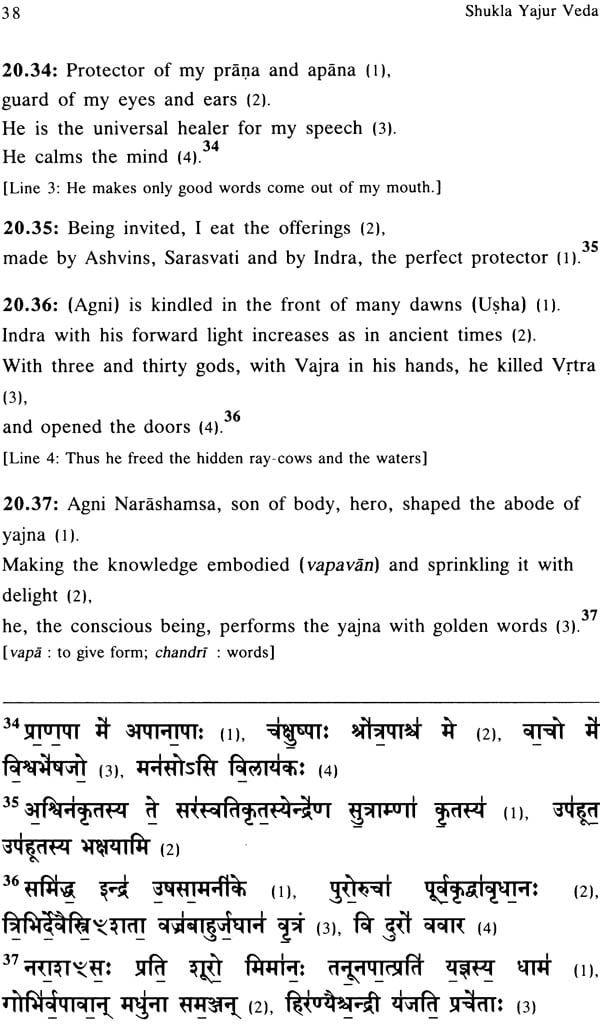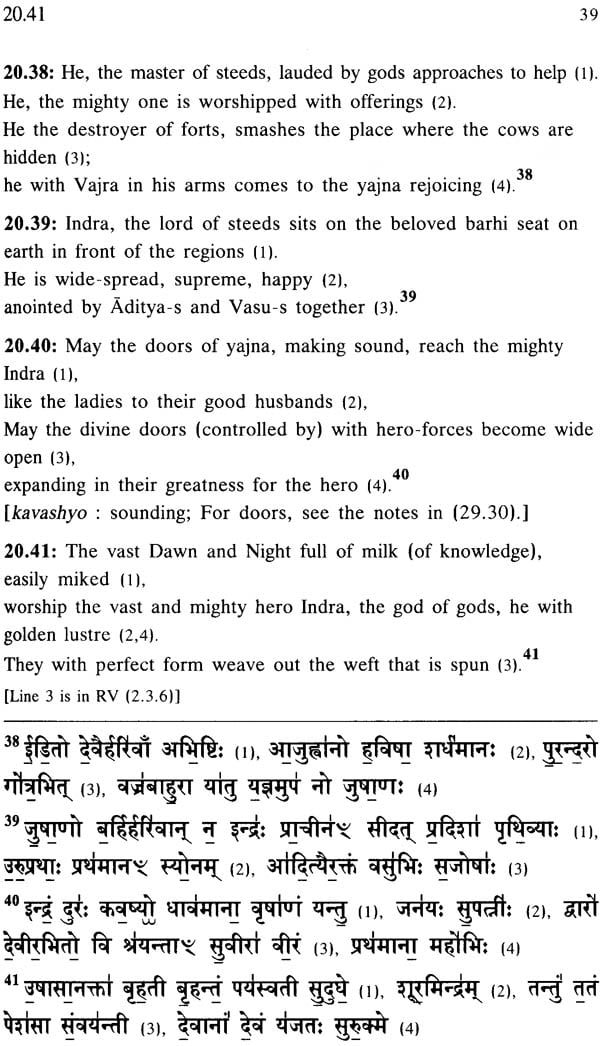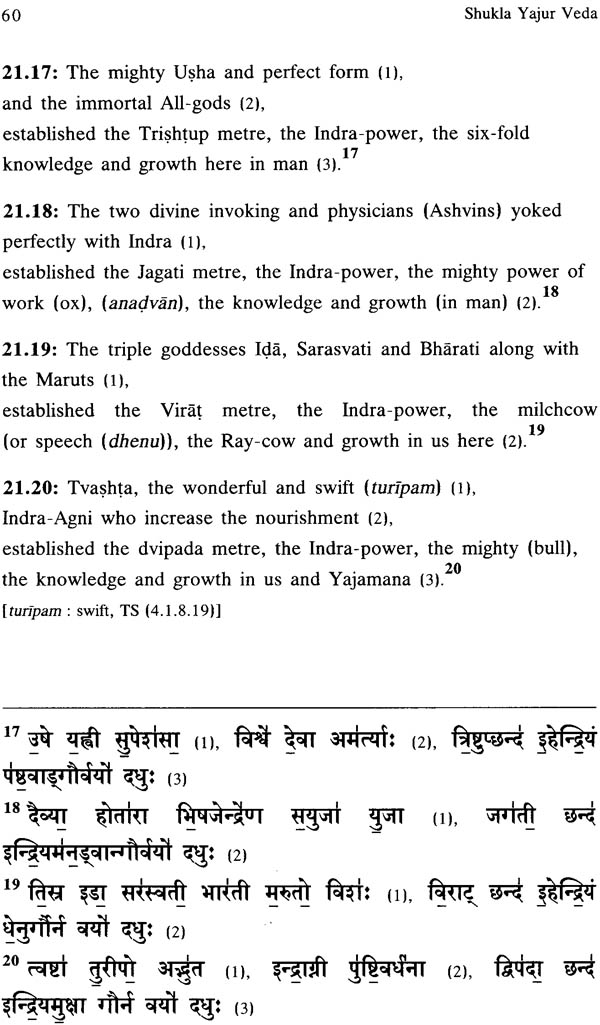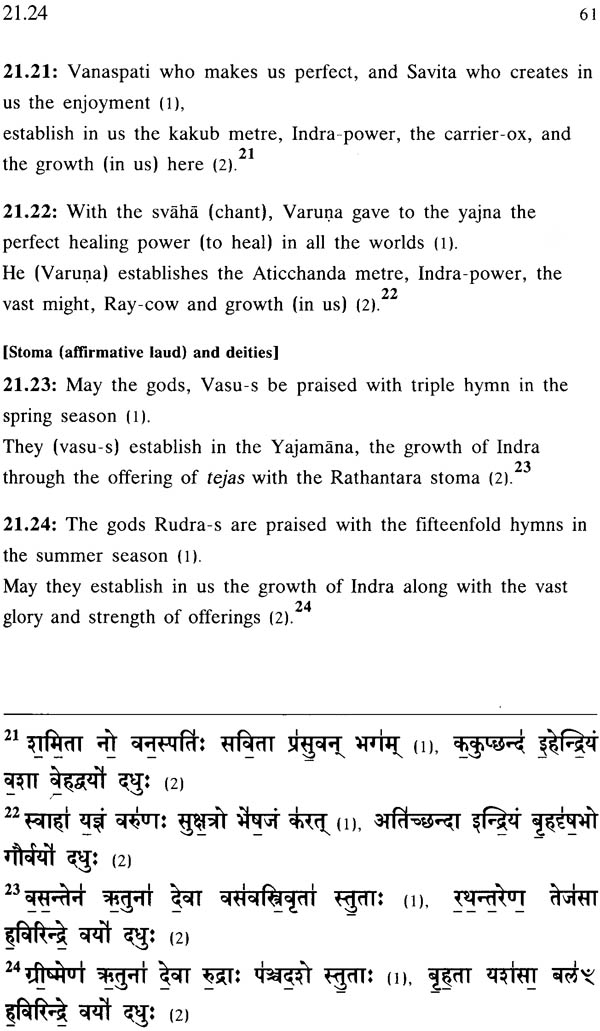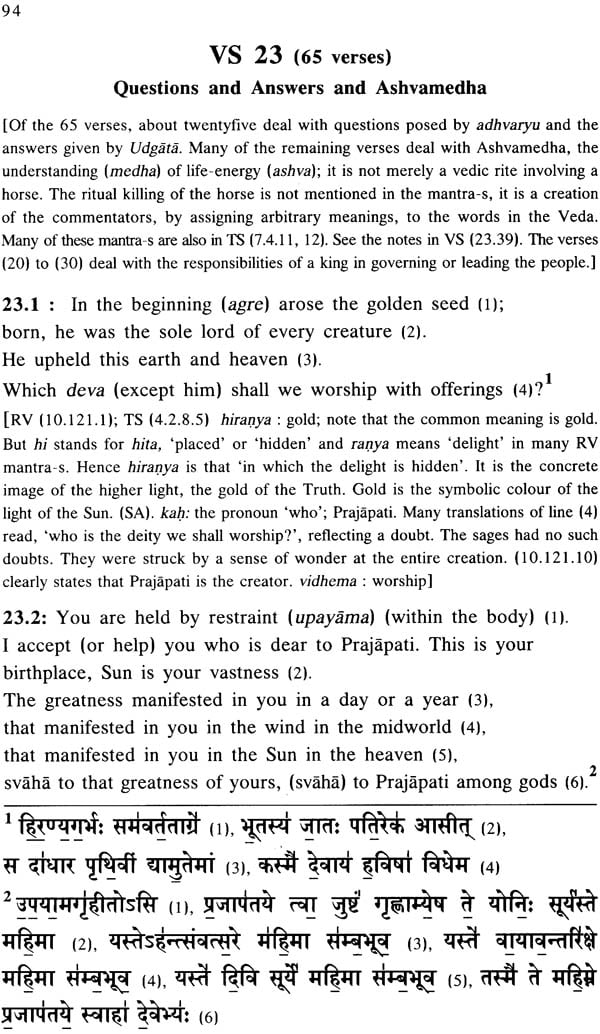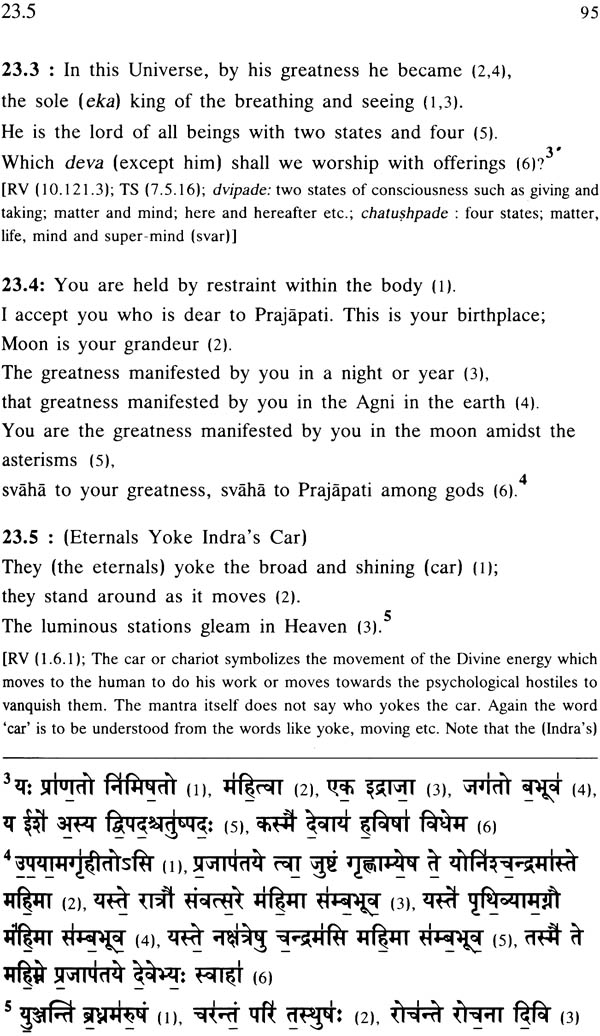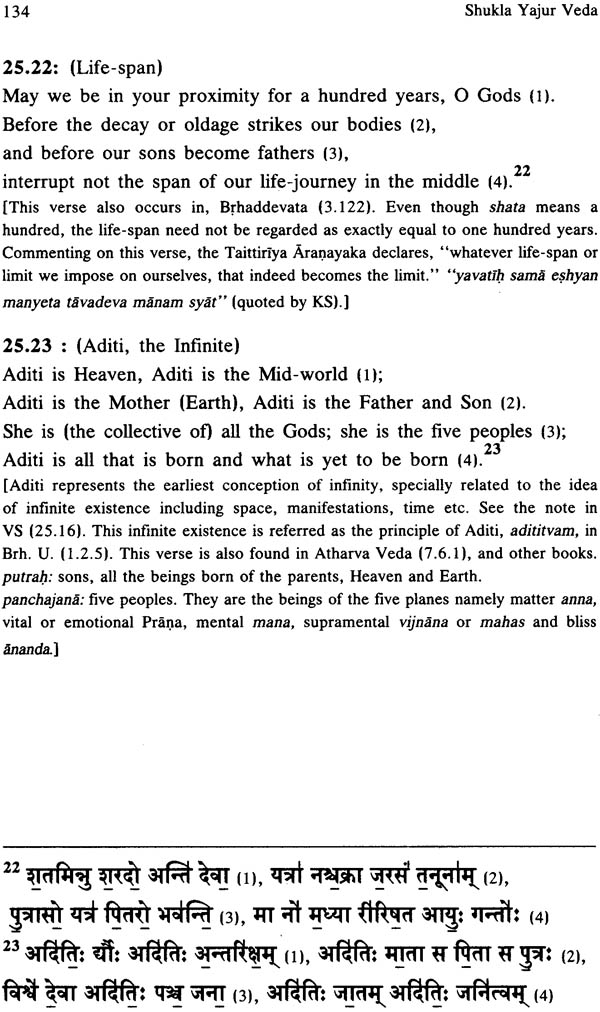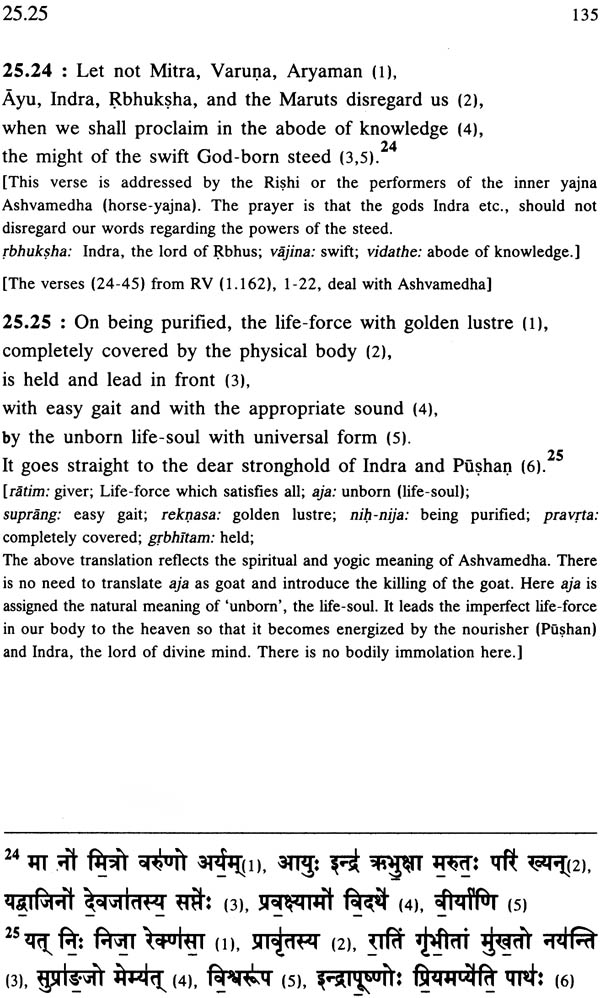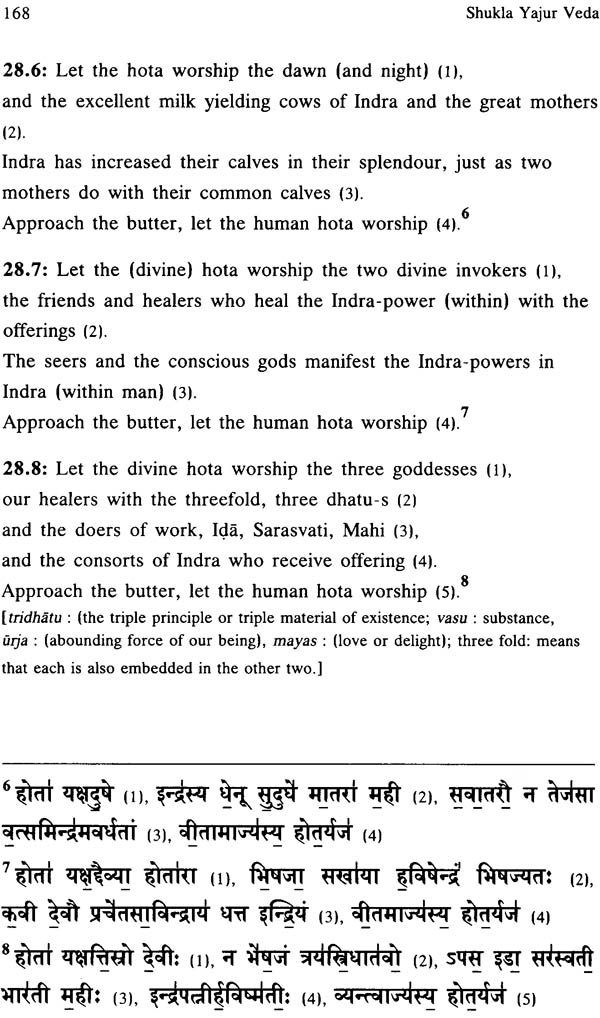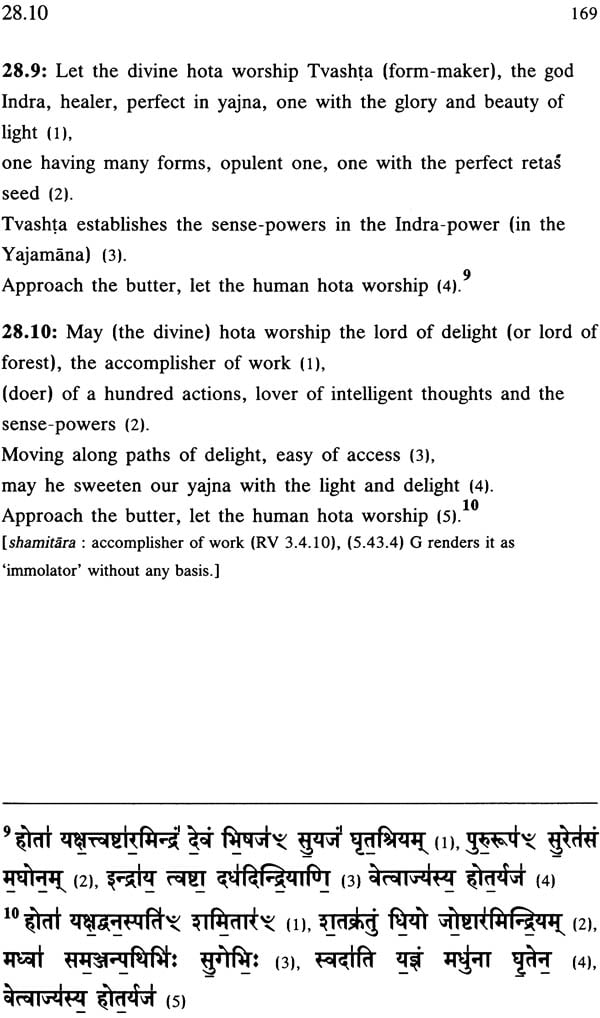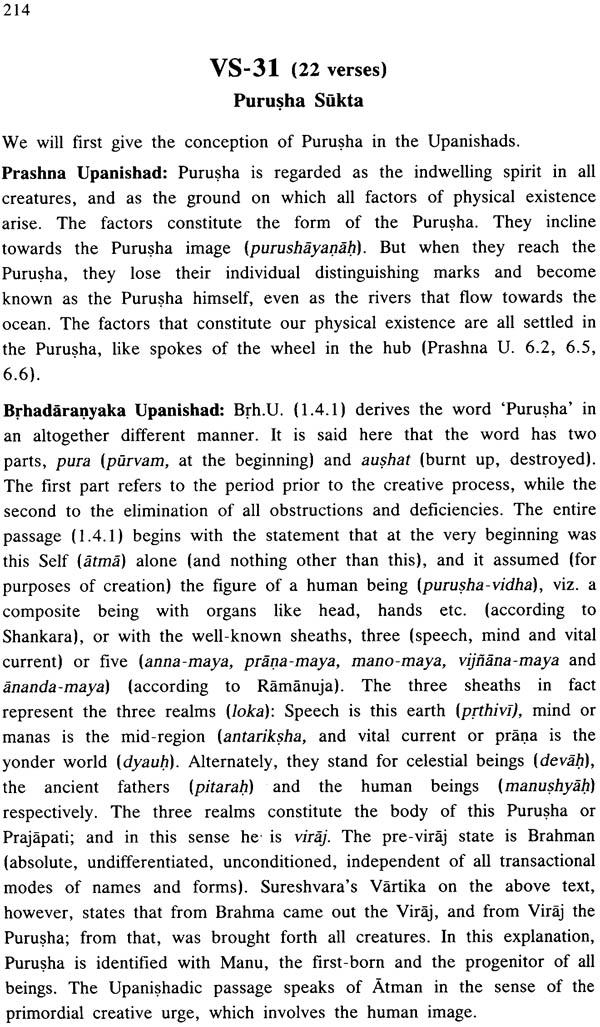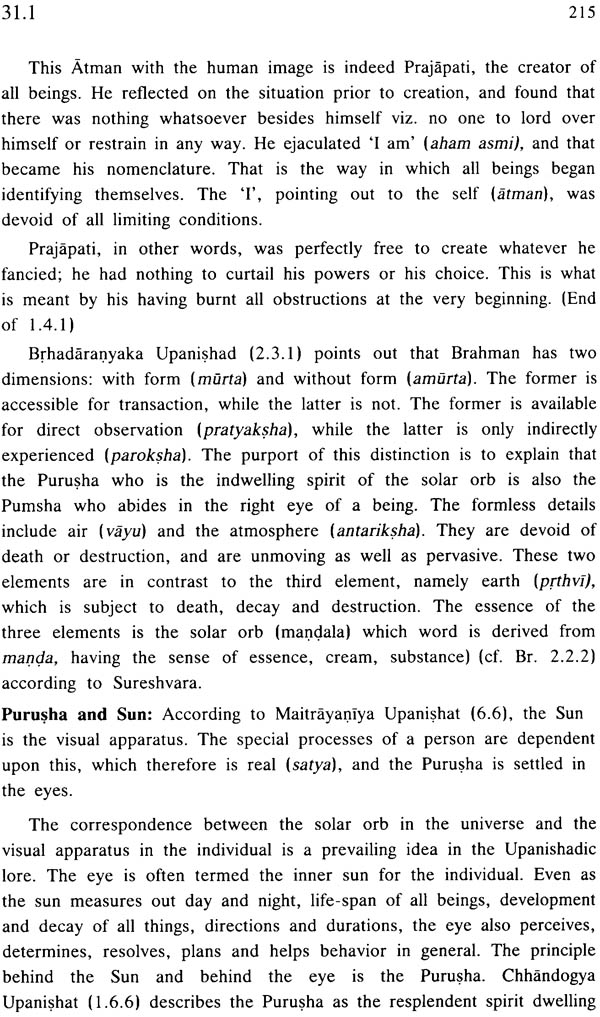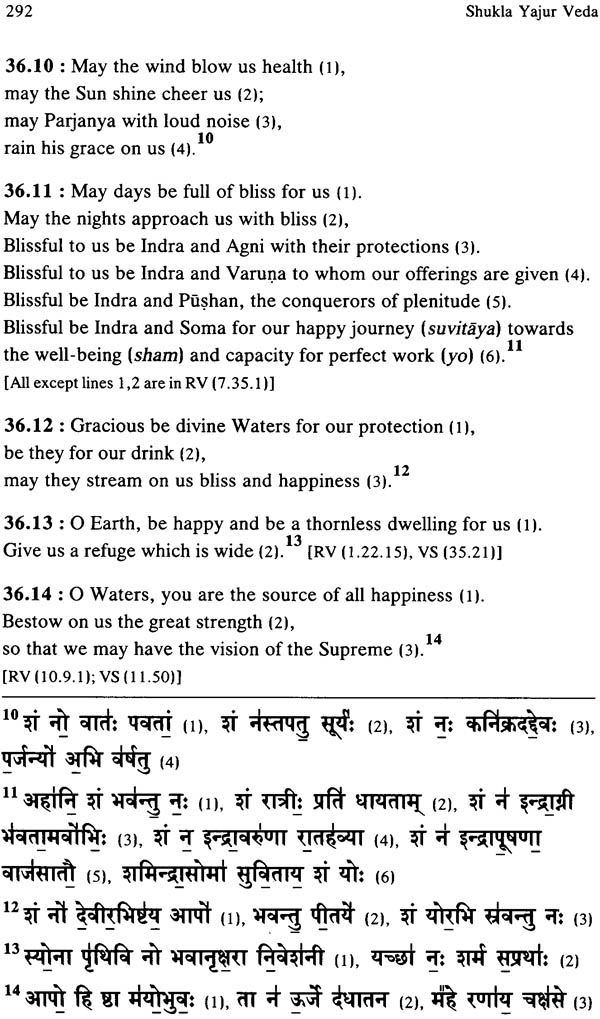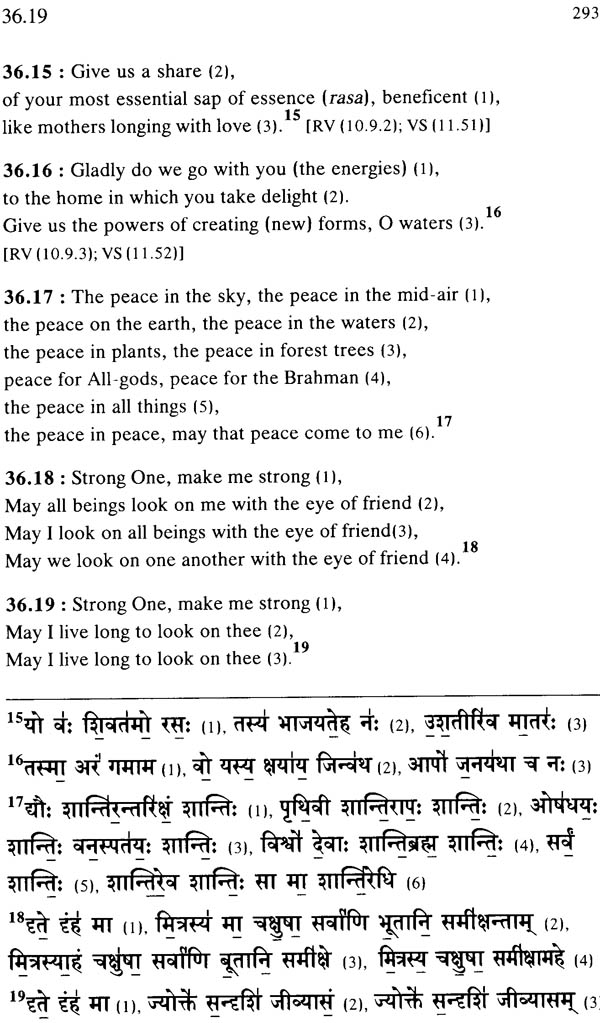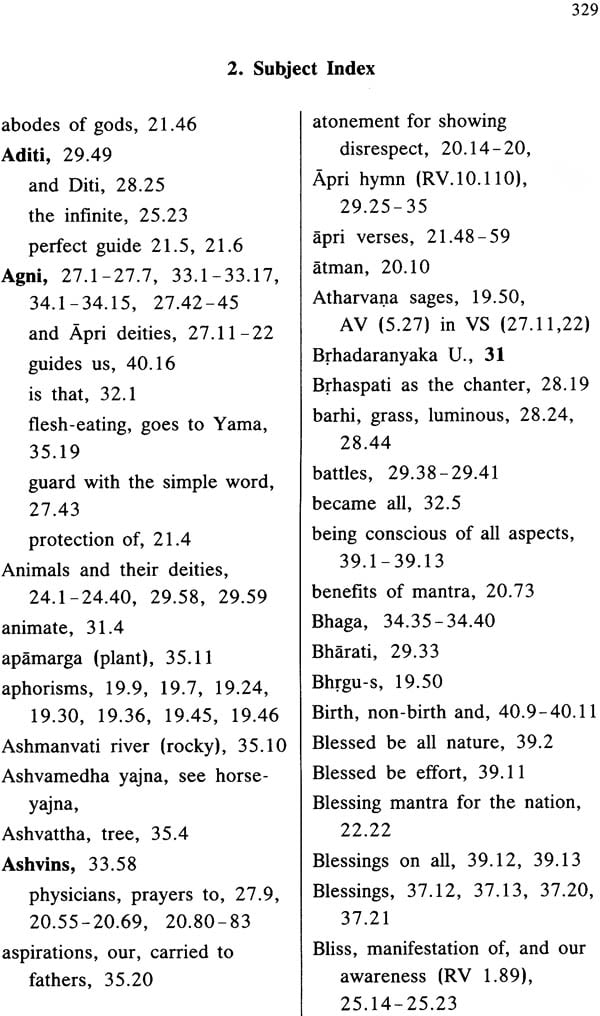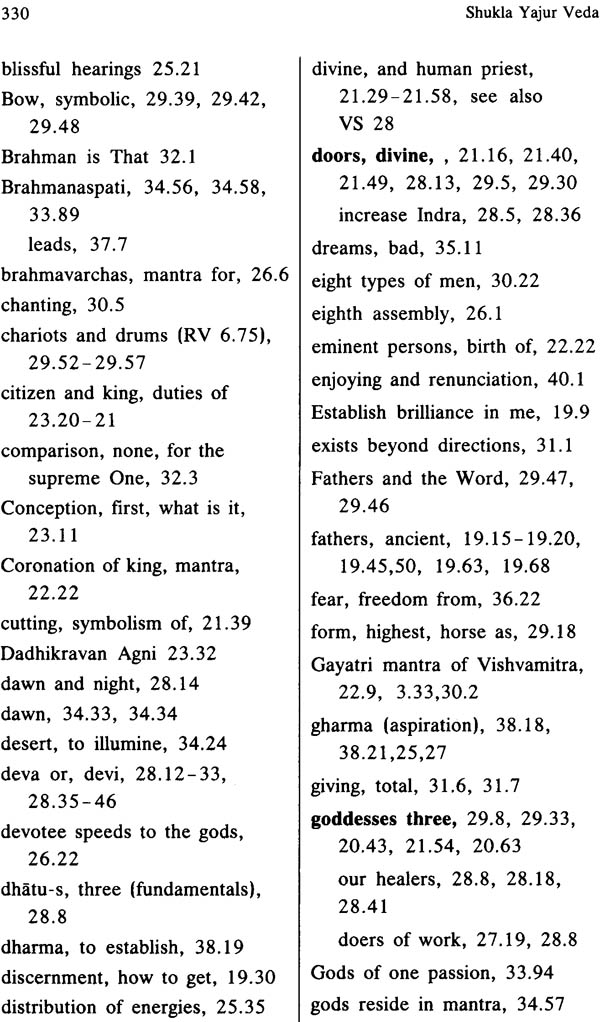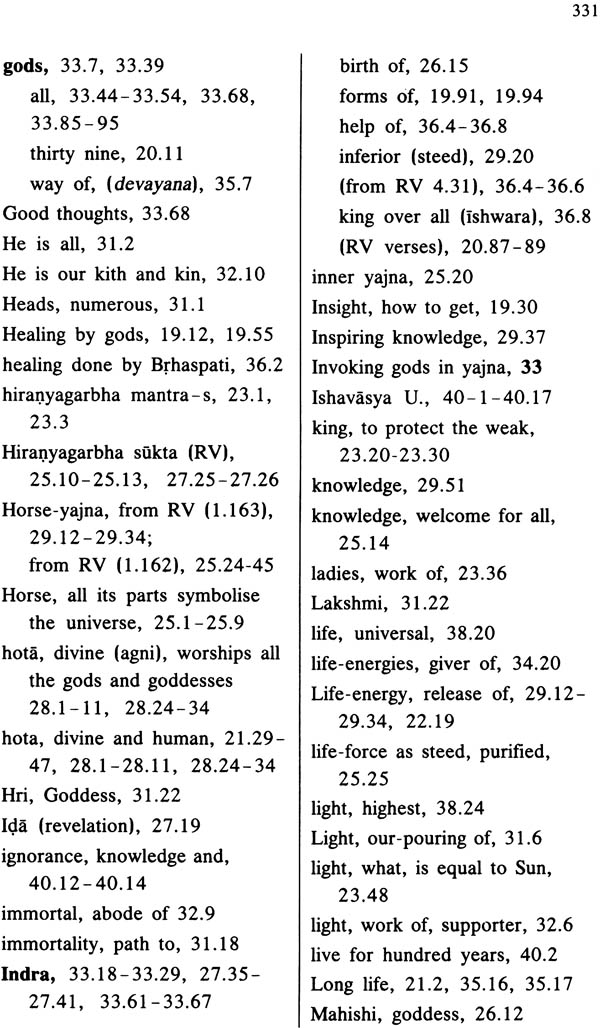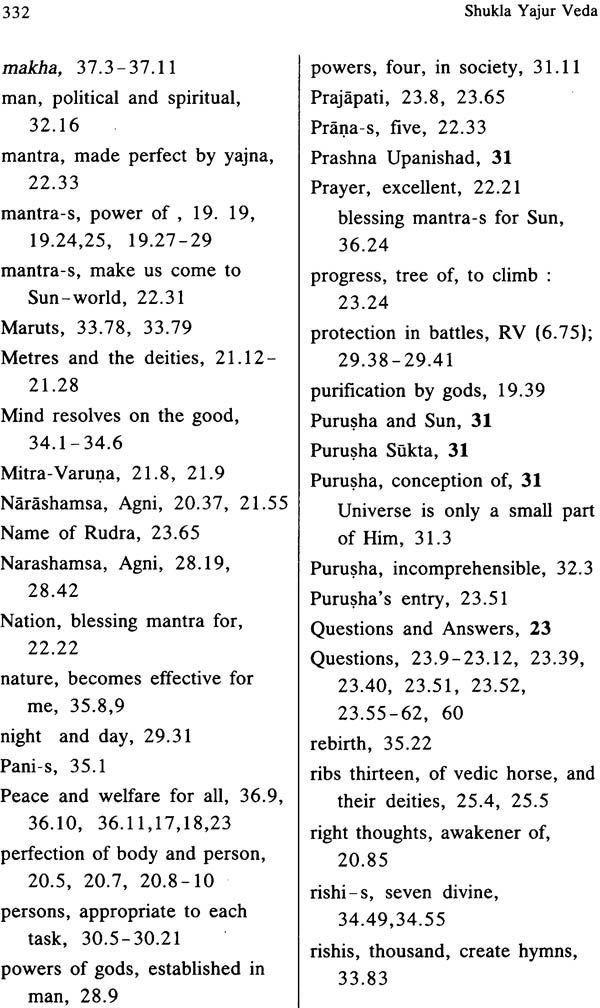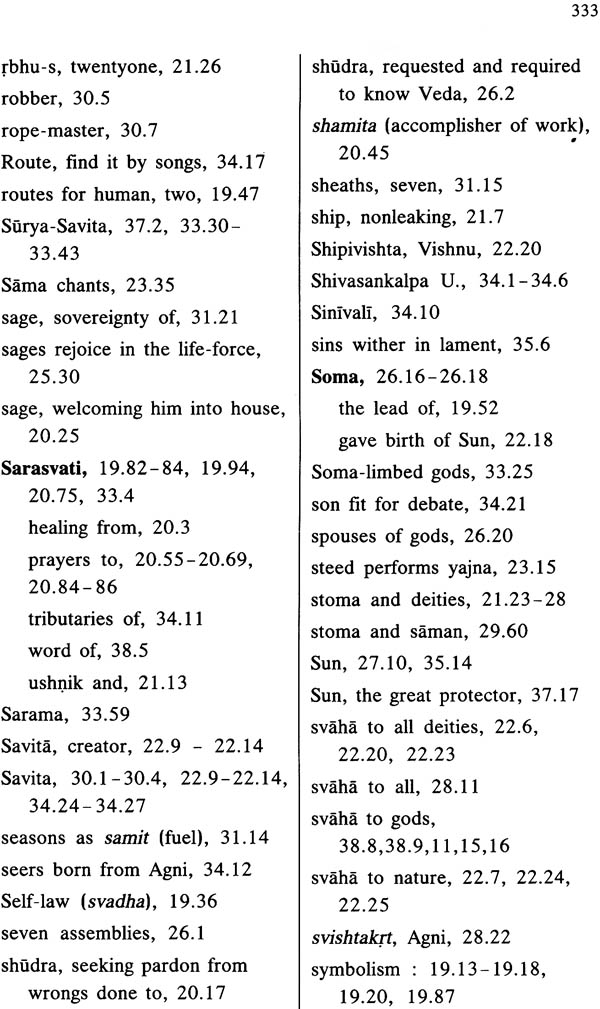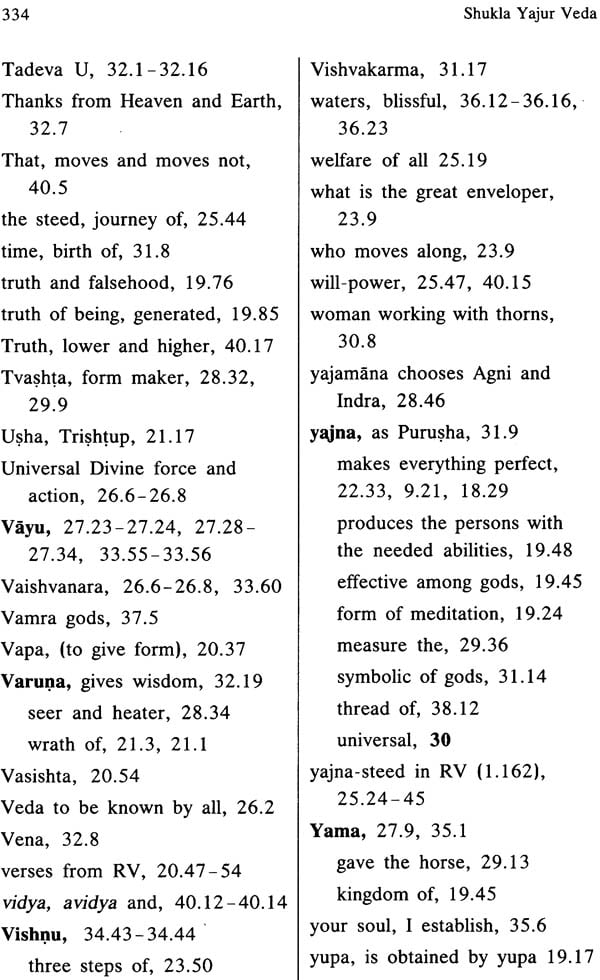
Yajur Veda: Vajasaneyi Samhita (Sanskrit Text, English Translation and Explanatory Notes) (Set of 2 Volumes)
Book Specification
| Item Code: | NAE963 |
| Author: | R.L. Kashyap |
| Publisher: | Sri Aurobindo Kapali Sastry Institute of Vedic Culture |
| Language: | Sanskrit Text with English Translations |
| Edition: | 2012 |
| ISBN: | 817994025X |
| Pages: | 752 |
| Cover: | Hardcover |
| Other Details | 8.5 inch X 6.0 inch |
| Weight | 1.15 kg |
Book Description
Dr. R.L. Kashyap is professor emeritus of electrical and computer engineering at purude university Lafayette Indian in USA. He had his master degree from Indian institute of science, Bengaluru and obtained Ph. D. from Harvard University. He is the recipient of many international award. In 2003 he has received Vedanta Vidvan award instituted by Maharshi Sandipani body of HRD Govt. of India.
He has authored more than 350 research articles of which 220 are publishes in scholarly journals and the rest were presented at conference. He has guided above 50 doctoral students.
He has written extensively on Veda. Some of is widely read books on Veda are: Rig Veda Samhita (12 Volumes), Yajur Veda’ (4 Volumes), Sama Veda’ (2 Volume) Atharva Veda’ (6 Volumes), why read rig Veda Rudra Mantra essential of Rig Veda. Work enjoyment & progress.
He is the honorary director of Sri Aurobindo Kapila Sastry Institute of Vedic culture, Bangalore.
Volumes 1st
As is well known the Yajur veda Samhita has two well known recensions or versions namely Krishna and Shukla. This book is the first part of one recension of shukla Yajur veda known as vajaseneya madhyanadina denoted as Vs. VS has in all 40 chapters or adhyaya-s with 1975 verses having both metrical (riks) and non- metrical (prose Yajus). This book gives the text of the first eighteen chapter along with translation and notes having 1026 verses. It may be recalled that Sakshi already published the text and translation of one version of Krishna Yajur veda the so called Taittiriya Samhita having seven kanda-s.
The focus here is on the inner yajna which takes place in our subtle body. Of course there is close correspondence between the inner yajna involving the offering to the fire in the altar of ghee, fuel, soma juice along with the recitation of the rik and saman mantra.
The highlights of this book are the two well known litanies to Rudra namely the namaka in chap. 16 and the cahmaka in chap. 18. These two litanies are almost identical to the corresponding litanies occurring in the Krishna Yajur Taittiriya Samhita in its kanda 4 Prapathaka-s 5 and 7. This feature is one of he commonalities in the two Yajur veda versions.
All the mantra-s here are either metrical riks or the prose yajur many o the rik mantra (not all) are in the current Rig Veda samhita. The remaining rik mantra-s were either present in some version of Rig veda now lost: or they were revealed to the compilers of the Yajur Veda-s the important point is to become free of the misconception that Yajur veda has only yajus or prose mantra-s the second misconception is that Yjur veda gives the details of the various outer yajna-s or rites.
Yajur veda has no such detail. It does contain word occurring in the outer ritual like vedi (altar), Chamu (ladle) etc. but these words have spiritual meanings indicated by the mantra-s themselves in various places.
Another popular misconception is that a rik mantra occurring in both rig veda and yajur veda has different meaning. We do not agree with this view. Each rik mantra is made of three or four distinct pada-s or quarters. By and large each pada is a well defined sentence or a clause having only a small number or words and this sentence or a clause having only a small ideologist give a summary translation of the entire verse without indicating the quarters separately. Sometimes their own ideas come there which are not in the text. In our book we translate ach pada of mantra separately. Sanskrit is a rich language in which several completely different meaning are possible for the same verse. For instance see the verses quoted at the end of appendix 6 titled references.
Many of the translator of Yjaur veda have forced their own meanings on the verses implying animal sacrifice and other unseemly features. But this has been achieved by assigning arbitrary meanings to the words as we have demonstrated in our TS book. Summing up we do not claim the meaning we have assigned to each verse is only the true one. Other meanings re possible. But evidence has to be given for the assignment of the meanings of the words.
Many of the agni mantra-s occurring in this book are in Rig Veda for which Sri Aurobindo has given his translation. We have used translation with appropriate modification. All the translations of Rig veda mantra-s of this book are same as the translation occurring in our Rig Veda books published by Sakshi.
The entire VS book has been rendered into English by R.T.H. Griffith in 1899 [16] without giving the text. A summary translation is given for each verse without given for each verse without indicating the detail. The translation is based on the Sanskrit commentary of Uvata and mahindhara. Both these commentaries assume that the mantra-s of VS deals exclusively with the rites. Accordingly each chapter is given a title indicating the relevant outward rituals. For instance the first two chapter are entitled Darsha puranamasa mantra. The translator Griffith adds in his introduction books I and II contain text and the formulas required at the New and full moon sacrifice the regular performance of which is obligatory on the Brahmanical householder during his life time. What he calls as formula-s are the detail for the performance of the rik. For instance the verse (1.2) is said to deal with the fastening the strained made of Kusha or darbha grass on the hidden branch of shami tree. However the verse itself gives no such details. It has the word Pavitra translated as strainer or purifier.
The well known book shatapatha Brahmana (SB) does gives explanation for many mantra-s of the entire book. These explanation have great depth viewing the outer yajna from a deeper point of view. Of course it was suggested to us that we should give the explanation of SB also. S is not a small book its English translation is in 5 volumes. Including the explanations of SB would greatly increase the size of our book which is not small as it is we will explore the possibility elsewhere. Our book deals with the first 18 chapter of VS. we have divided in into 2 groups VS (1) VS and VS (II)- VS (18). The first group has several yajna-s including the soma yajna vajapeya and Rajasuya (mantra-s only). We label the entire second part as vedic yoga. All the 8 chapter develop this yoga VS (16) is the namaka hymn having the various epithets to rudra. Here we have attempted to provide a deeper or spiritual meaning to the epithets wherever possible. The entire chapter VS (16) is almost identical to TS (4.5). it has the famous mantra namaha shivaya. The eminent scholar and savant prof. S.K. Ramachandra Rao specifically appreciated the translation of the epithets he said that he had not seen anywhere the else such an attempt even though both the Namaka (VS(16)) and chamaka (VS (18)) are frequently recited, both at homes and in the yajna performance. The chamaka hymn (VS (18)) is viewed as the list of powers of gifts which flow to the yajna performer as a result have tried to give a deeper interpretation of the gifts requested.
Another interesting feature of VS is that several verse are repeated in other chapters. We have given the relevant Rig veda references wherever applicable; however it is not complete. If a verse is repeated in VS if it also occurs in Rig Veda and in TS and other places it must have some importance. Hence we can focus on these mantra-s at the first reading.
The yajus mantra-s here fall into 3 categories.
(i) A shorty pithy phrase like namah shivaya occurring in VS (16)
(ii) A phrase of 8 to 12 words
(iii) A long sentence with 40 or 50 words without any punctuation.
One of the contributions of this book to break up these long yajus mantra-s of type (iii) into 8 to 10 separate parts each having 6 to 10 words as in category (ii). Examples of this of this category is the widely quoted verse 9.21 (same as 18.29, 22.33) (with the phrase yajnena Kalpantam) which has 29words and 17 more words for a total of 46 words: consider (15.6) having 44 words or (5.10) (5.14) each having about 5 words or (13.53) having about 77 words.
Volume 2nd
This book contains the text and translation of all the 949 verses in the chapter 19through 40 of the shukla Yajur veda Vajasaneya samhita (VS). this book complement the book published by Sakshi in August 2012 containing the text and translation of 1026 verse of the VS titled part 1 having chapter 1 through 18. The current book is part 2. Together they cover the 1975 verses of SYV VS, having 40 chapters.
The twentytwo chapter here can be divided into two sections based on their contents. The first 12 chapters, VS 19 through VS 30 focus on the inner yajna which takes place in our subtle body. Of course there is close correspondence between the inner yajna and the outer yajna involving the offerings to the fire. This section including the famous Ashvamedha yajna meaning the intelligence (medha) of the life (Ashva). More on this topic a little later.
It is well known that the last chapter VS-40 is almost identical to the Ishavasya Upanishad the first name among the ten major Upanishadas. Since many traditionalists regarded all the veda samhita especially the Yajur veda s purely ritualistic they have declared that the last chapter is an anomaly or abnormality. This is incorrect. All the last 10 chapter VS 31 through VS 40 are philosophical can some of them appear in the list of 108 upanishads. For instance VS 31 is nothing but the well known purusha hymn which occurs with variation in all the four Veda samhita-s. this Upanishad and the Tadeva Upanishad (VS 32), along with isha and shatarudriya (VS 16) are including in the famous collection of sixty Upanishad entiled oupenkhat which was the first veda book to be translated into a foreign language namely Persian the translation being supervised by the famous scholar the Moghul prince Darashuko of seventeenth century CE. VS 34 has the famous Shvansankalpa stota of Upanishad.
VS 33 has 97 mantra-s mostly from RV. Here all the principal gods and goddesses such as Agni Indra, Surya are invoked one by one to manifest in the body of the aspirant and thus render the being whole of complete.
One usually assumes that Veda-s are ritualistic and hence it is assumed that no question are posed. It is said that the habit of posing question appears only in the Upanishad. But the question are posed in the Rig Veda and other veda-s many of these question and some original ones are present in VS 23. The posing of question is marked by humility. Rishi claims that he being ignorant is posing question to the wise he himself gives an answer also. An interesting question found here and also in RV is the question what is the limit of the Earth?
A widespread misconception among hindu-s is that shudra-s and omen are not eligible to read Veda-s this statement is totally false VS calls upon the rishis to teach veda for shudra a complete stranger women without any limitation. In VS the sag and king pray for pardon from the shudhra for showing disrespect. Similar vrses are there in atharva veda also.
Three chapter in VS, VS 23, VS 25 and VS 29 consider the rite of Ashvamedha (the intelligence medha associate with the life and TS the horse is said to symbolize all the aspects of the universe in VS (25.1 -25.9) as sri Aurobindo states ashva means originally being existence substance from the sense of speed and strength it came to mean a horse. The word ashva is therefore used to indicate material existence and the horse (the image conveyed by the name) is taken as the symbol of universal existence in the material sheath (annam) rig veda has two important sukta-s dealing with Ashvamedha namely RV (1.162) and RV (1.163). RV (1.162) is in the verse (25-45) of VS 25. RV (1.163) is in VS (29.12)-(29.34).
Volumes 1st
| (i) | Acknowledgement | VI |
| (ii) | Note to the Readers | VII |
| (iii) | Overview of Yajur Veda | XI |
| (iv) | The all pervading spirit and the supreme person | XII |
| (v) | Yajur Veda and rites | XIII |
| (vi) | Elements of inner yajna | XIV |
| (vii) | Vedic yoga | XVII |
| (viii) | Mantra-s and their power | XX |
| (ix) | Rishi-s | XXII |
| (x) | Overview of the power of Gods | XXIII |
| (xi) | Gods: their symbolism and power | XXV |
| (xii) | Common words as symbols | XXVII |
| (xiii) | Related Veda books | XXVII |
| (xiv) | Information in Appendices | XXVIII |
| (xv) | Abbreviations | XXX |
| I | The text translation and notes on 1026 mantra-s | |
| (i) | VS (I) VS (10) (430 Verses) | 1 |
| (ii) | VS (II) VS (18) (596 Verses) | 137 |
| (Details of I in next page) | ||
| II | Appendices | |
| 1 | Inner and outer Yajna: Concordance | 342 |
| 2 | Inner Yajna in the Upanishads | 345 |
| 3 | Prana of life energy | 349 |
| 4 | Refutation of some popular misconceptions of Yajur Veda | 350 |
| 5 | Spiritual Meaning of some words | 354 |
| 6 | References | 356 |
| 7 | Subject index | 360 |
| Details of Section I | ||
| VS 1 | A simple inner Yajna | 1 |
| VS 2 | Inner Yajna-2 Agni, Savita, Father | 11 |
| VS 3 | Rekindling the fire of aspiration | 21 |
| VS 4 | Inner soma Yajna-1 | 38 |
| VS 5 | Inner soma Yajna-2 | 50 |
| VS 6 | Inner soma Yajna-3 | 64 |
| VS 7 | Inner soma Yajna-4 | 76 |
| VS 8 | The conclusion of the inner soma yaga | 93 |
| VS 9 | Vajapeya yajna | 112 |
| VS 10 | Royal consecration | 125 |
| VS 11 | Developing the aspiration (inner fire) | 137 |
| VS 12 | Preparing the body of bearing the kindled inner fire | 169 |
| VS 13 | Development of subtle body Part 1 | 202 |
| VS 14 | Development of the subtle body Part 2 | 223 |
| VS 15 | Heaven within us and the sun world | 238 |
| VS 16 | Namak hymn to rudra-shiva | 262 |
| VS 17 | Maturing the body to hold the divine energies | 286 |
| VS 18 | Chamaka hymn and others | 316 |
| Tables | ||
| Table 1 | (Manifestation) | 222 |
| Table 2 | (Establishment of inner heaven) | 245 |
| Table3 | (Five Impellers) | 248 |
Volumes 2nd
| (i) | Acknowledgement | V |
| (ii) | Note to the reader | VI |
| (iii) | Overview of the power of the Gods | XI |
| (iv) | The cosmic power: their symbolism and power | XIII |
| (v) | Common words as symbols | XV |
| (vi) | Abbreviations | XV |
| I | The Text, translation and notes on 949 mantra-s | |
| VS 19 | Power of mantra-s father, symbolism and aphorisms | 1 |
| VS 20 | Saraswati, Ashvins, Indra and other Gods | 29 |
| VS 21 | Varuna, Agni, Aditi, Metres and Apri verses | 55 |
| VS 22 | Svaha to all the deities; Blessing mantra for a nation | 80 |
| VS 23 | Question and answers and Ashvamedha | 94 |
| VS 24 | Animal and their Deities | 112 |
| VS 25 | Ashvamedha and the manifestation of Bliss | 124 |
| VS 26 | Veda to be known by all | 145 |
| VS 27 | Agni, Vayu and Indra | 153 |
| VS 28 | The Divine and human hota; the gods and goddesses | 166 |
| VS 29 | Internal yajna | 185 |
| VS 30 | Universal Yajna (Persons appropriate to each task) | 206 |
| VS 31 | Purusha sukta | 214 |
| VS 32 | Tadeva Upanishads | 228 |
| VS 33 | Invoking the various gods in the internal yajna | 233 |
| VS 34 | Shivasankalpa and the gods of bliss | 262 |
| VS 35 | Pani-s Savita, Tree, Sun and Agni | 282 |
| VS 36 | Peace, Amity and Bliss | 288 |
| VS 37 | Makha and prayers for blessings | 296 |
| VS 38 | Prayers for various powers | 304 |
| VS 39 | Being conscious of all aspects | 314 |
| VS 40 | Ishavasya Upanishad | 319 |
| II | Appendices | |
| 1 | Spiritual meanings of some words | 327 |
| 2 | Subject index | 329 |
